- Missiles of the World

3M-14 Kalibr (SS-N-30A)
The 3M14 Kalibr (NATO: SS-N-30A) is a Russian land attack cruise missile (LACM) and improved version of the 3M-14E “Club” LACM. The SS-N-30A has an estimated range of around 1,500 to 2,500 km and has become a mainstay in the Russian Navy’s ground-strike capabilities.
Kalibr (SS-N-30A) at a Glance
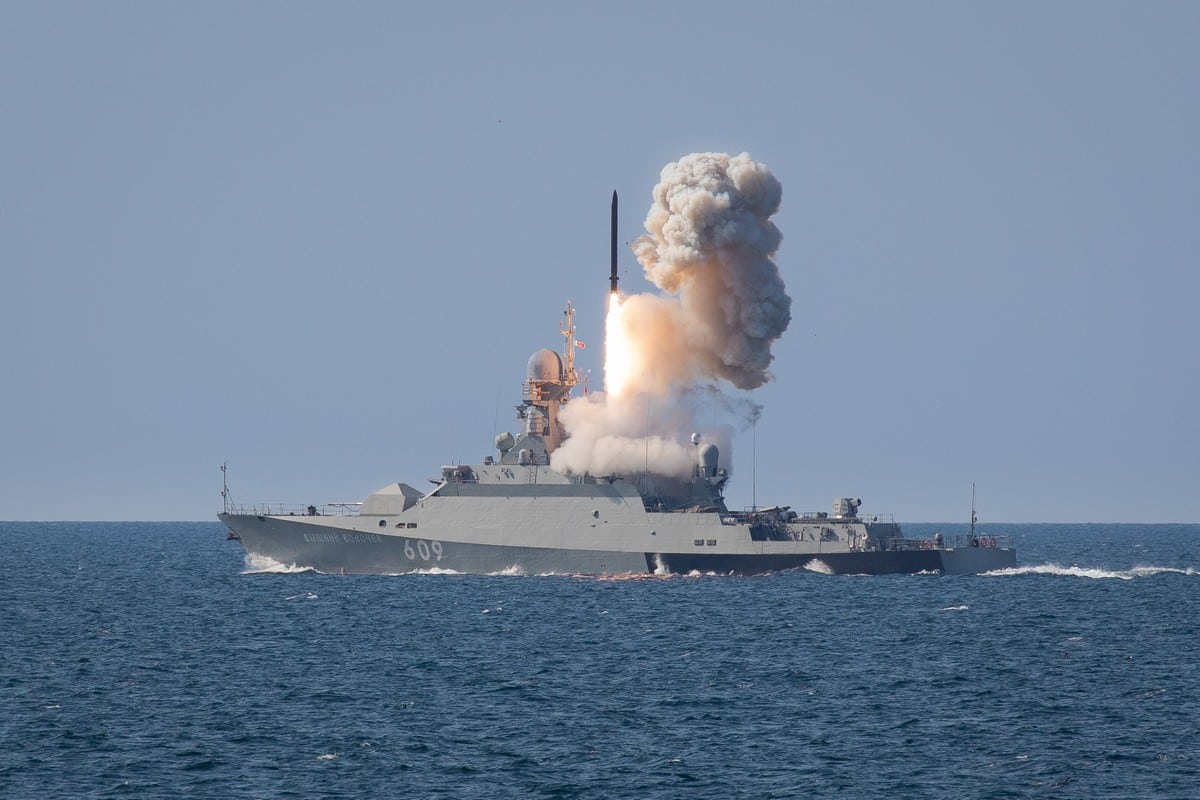
Kalibr Development
Although commonly referred to as the Kalibr cruise missile in media reports, the SS-N-30A is in fact just one part of the larger Kalibr family of Russian sea-launched missiles, which includes the SS-N-27 (Sizzler) anti-ship cruise missile and the 91R anti-submarine missile. All three Kalibr missiles share common Kalibr vertical launch system (VLS) tubes, which are quickly becoming a mainstay of the Russian Navy’s cruise missile launch capabilities. According the U.S. Office of Naval Intelligence, a “high ranking Russia defense industry official” said of Kalibr system in 2011:
“Russia plans to deploy KALIBR capability on all new design construction nuclear and non-nuclear submarines, corvettes, frigates, and larger surface ships. KALIBR provides even modest platforms, such as corvettes, with significant offensive capability and, with the use of the land attack missile, all platforms have a significant ability to hold distant fixed ground targets at risk using conventional warheads. The proliferation of this capability within the new Russian Navy is profoundly changing its ability to deter, threaten or destroy adversary targets. It can be logically assumed that KALIBR capability will be retrofitted on those larger Soviet legacy ships and submarines that undergo major overhauls and/or modernization.” 1
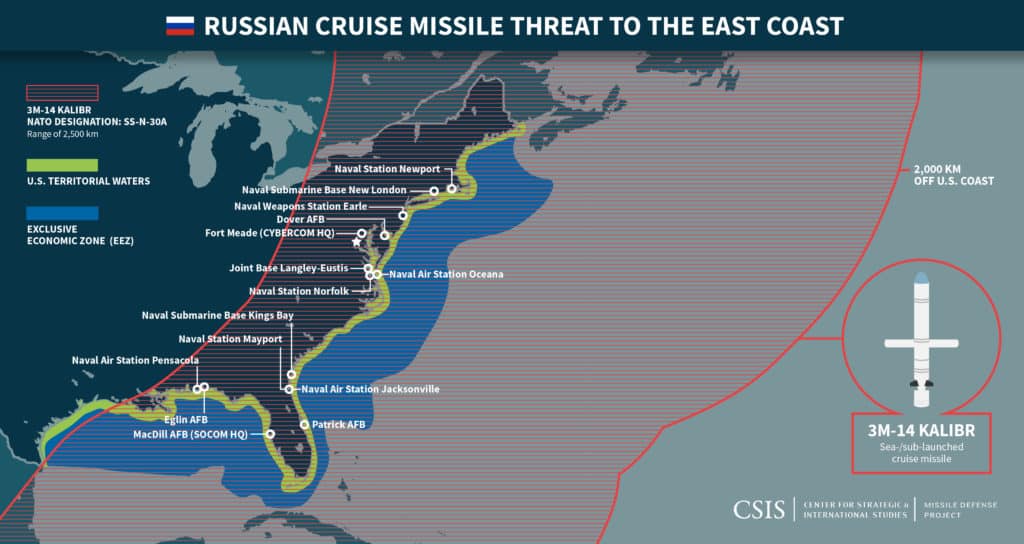
Service History
Export variants.
- Office of Naval Intelligence, The Russian Navy: A Historic Transition (Office of Naval Intelligence, December 2015): 33, http://www.oni.navy.mil/Portals/12/Intel%20agencies/russia/Russia%202015print.pdf?ver=2015-12-14-082038-923.
- Christopher P. Cavas, “Is Caspian Sea Fleet a Game-Changer?” Defense News , October 11, 2015, http://www.defensenews.com/story/defense/naval/ships/2015/10/11/caspian-sea-russia-navy-missiles-attack-strike-military-naval-syria-frigate-corvette-lcs-littoral-combat-ship/73671188/
- USNORTHCOM and NORAD Posture Statement: Hearing before the Committee on Armed Services, Subcommittee on Strategic Forces House of Representatives, 114th Cong, 2 (April 14, 2016) (statement by Admiral William E. Gortney, Commander, U.S. Northern Command and North American Aerospace Defense Command), http://docs.house.gov/meetings/AS/AS29/20160414/104621/HHRG-114-AS29-Wstate-GortneyB-20160414.pdf
- Vladimir Isachenkov, “Russia conducts war games involving numerous missile launches,” Associated Press, October 30, 2015, http://www.usnews.com/news/world/articles/2015/10/30/russia-holds-war-games-involving-numerous-missile-launches
- Janes’s Weapons, Naval 2012-2013 (Janes Information Group, 2012), 15.
- “Russia Beefs Up Baltic Fleet Amid NATO Tensions: Reports”, Reuters, October 26, 2016, http://www.reuters.com/article/us-russia-defence-baltic-sweden-idUSKCN12Q1HB.
- Mission Statement
- Advisors to the Board
- Military Fellows
- Jobs at MDAA
- Arizona AETOS ’25
- Hawai’i Space Science Initiative
- USC SHIELD ’24
- USC SHIELD ’23
- USC SHIELD ’22
- USC SHIELD Alerts
- USC SHIELD in the News
- Ronald Reagan Missile Defense Site, Vandenberg SFB
- Kauai Veteran’s Eternal Memorial and Missile Defense Viewing Site
- Lessons Learned Series
- Write Your Representative
- April 12th, 2022 U.S. Missile Defense – An Overview of Past, Current, and Future Roles and Responsibilities
- Virtual CRT: U.S. Missile Defense – An Overview of Past, Current, and Future Roles and Responsibilities
- MDAA Alert: The Roles and Responsibilities of Missile Defense
- Threat News
- Missile Defense News
- Air Defense News
- MDAA in the News
- Threat Basics
- Ukrainian War Updates
- Taiwan Incursion Updates
- Global Missile Tracker
- Space Threats Updates
- Notable Missile Tests
- Combat Launches
- Future Missile Threats
- U.S. Missile Defense
- Missile Defense of U.S. Partners
- Missile Defense Intercept Test Record
- Operational Intercepts by System
- Future BMD Systems
- Discontinued Programs
- U.S. Air Defense
- Air Defense of U.S. Partners
- Future Air Defense Systems
- Alerts Archive
- MDAA U.S. Ballistic Missile Defense Overview
- MDAA System/Issue Briefs
- MDAA Country Briefs
- Foreign Military Sales by Country
- 3D Panoramas
- Additional Resources
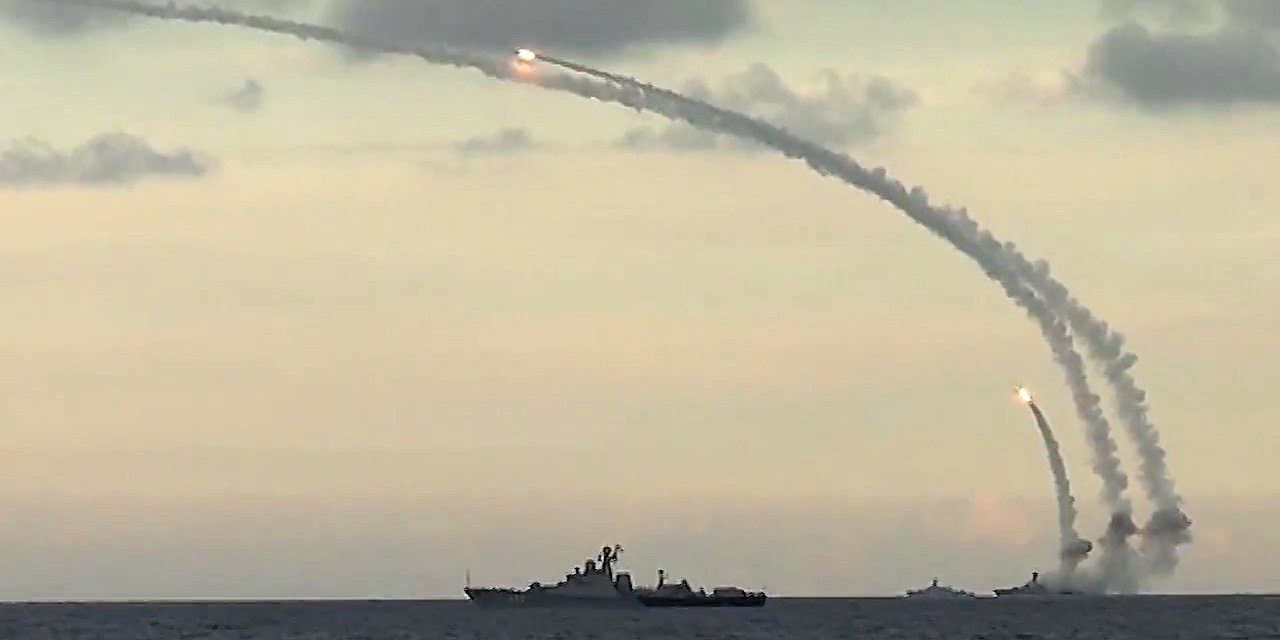
- 3M-14 Kalibr (SS-N-30A)
Russia’s Kalibr cruise missiles are believed to be the land-attack version the Klub family cruise missiles, yet, not much is currently known about these variations. The 3M-14T Kalibr-NK is a land-attack cruise missile carried by Russia’s surface vessels. Reports put its max range at 1,500 – 2,500 km. In October and November 2015, Russia launched a salvo of Kalibr missiles from the Caspian Sea at ISIS targets inside Syria. The Kalibr-NK cruise missiles were launched from a Russian Gepard-class frigate and Buyan-M-class corvettes and travelled 1,500 km to reach their targets. It has been reported it is capable of carrying a 450 kg conventional or (reported) nuclear warhead.
The missile is believed to fly 64 ft above the sea and 164 ft above the ground at speeds up to 965 km/hour. It is believed to be guided, using GPS and terminal-phase active radar seekers to achieve a reported three m CEP. The 3M-14K Kalibr-PL is similar to the 3M-14T except that is launched from a submarine. This variant was reported to have been launched from an improved Kilo-class submarine in the Mediterranean to strike targets inside Syria in December 2015. Russia plans to equip most of its submarines and surface ships with the respective versions of the Klub anti-ship and Kalibr land-attack cruise missiles. This will include ships in Russia’s Baltic Sea, Black Sea, Caspian Sea, Northern, and Pacific Fleets. Novator Design Bureau, the designers of the Klub launch system, have developed a shipping container version of the launcher, capable of holding up to four missiles. This shipping container version allows the cruise missile to be forward deployed on ships, trucks, and trains without detection.
Strategic Implications
The Russian plan to equip its submarines and surface ships with the Kalibr cruise missile poses a serious threat to the U.S. ability to project force across the globe. The Russian ships that carried out the 2015 strike all had a displacement around or under 1,000 tons. The 26 Kalibr missiles reportedly traveled 1,800 km, a significant distance for missiles launched from such small vessels. The small size of the Russian ships that carried out the strike offers them unique strategic opportunities, not to mention the fact that these naval vessels are relatively inexpensive. Despite significant Russian ground assets in Syria capable of carrying out such a strike, Russia elected to demonstrate its improvement with a longer-range sea-based launch. According to a U.S. official, this was done intentionally to display these enhanced capabilities. Beyond the immediate ramifications of the Russian strike on Syria with Kalibr cruise missiles, the strike showed that Russia has potentially strengthened its A2/AD capabilities to further limit US military operations in contested regions, which, in turn, will allow Russia to continue conducting hybrid warfare tactics and to punch above its own weight militarily.
Cavas, Christopher P. “Is Caspian Sea Fleet a Game-Changer.” Defense News . October 11, 2015. http://www.defensenews.com/story/defense/naval/ships/2015/10/11/caspian-sea-russia-navy-missiles-attack-strike-military-naval-syria-frigate-corvette-lcs-littoral-combat-ship/73671188/
Lewis, Jeffrey. “Sokov on Russian Cruise Missiles.” Arms Control Wonk . August 25, 2015. http://www.armscontrolwonk.com/archive/207801/sokov-on-russian-cruise-missiles/.
Akulov, Andrei. “Kalibr: Russia’s Naval System Upping Cruise Missile Game.” Strategic Culture Foundation. May 24, 2016. http://www.strategic-culture.org/news/2016/05/24/kalibr-russia-naval-system-upping-cruise-missile-game.html.
Johnson, Richard. “How Russia fired missiles at Syria from 1,000 miles away.” The Washington Post . October 23, 2015. https://www.washingtonpost.com/graphics/world/russian-cruise-missile/.
Missile Threat and Proliferation
- Missile Payload Destruction Cost Comparisons
- Technological Threat Assessment
- War By 2025 Threat Analysis
- Ballistic Missile Basics
- Hypersonic Weapon Basics
- Cruise Missile Basics
- Rocket and Mortar Basics
- Unmanned Aircraft System (UAS) Basics
- Non-State Actors
- Israel-Hamas War Updates
- United States Incursion Tracker
- World Drone Comparison
- Dong Feng-16 (CSS-11)
- Dong Feng-15 (CSS-6)
- Dong Feng-11 (CSS-7)
- M-7 (8610)/CSS-8
- Dong Feng-12 (CSS-X-15)
- Dong Feng-3 (CSS-2)
- Dong Feng-21 (CSS-5)
- Dong Feng-21D (CSS-5)
- Dong Feng-26
- Dong Feng-4 (CSS-3)
- Dong Feng-5 (DF-5)
- Dong Feng-31 (CSS-10)
- Dong Feng-41(CSS-X-20)
- DH-10 / CJ-10
- Changjian-20 (CJ-20)
- DF-ZF Hypersonic Glide Vehicle
- Dong Feng-17
- Chinese Spy Balloons
- Hwasong-17/KN-27
- Pukguksong-3 (KN-26)
- KN-02 (Toksa)
- Hwasong-5 (Scud-B Variant)
- Hwasong-6 (Scud-C Variant)
- Hwasong-9 (Scud-ER/Scud-D Variant)
- Polaris-2 (Pukguksong-2/KN-15)
- Taepodong-1
- Hwasong-12/KN-17
- Taepodong-2
- KN-08 / Hwasong-13
- Hwasong-14/KN-20
- Hwasong-15/KN-22
- 3M22 Zircon
- Avangard (Hypersonic Glide Vehicle)
- RS-26 Rubezh
- OTR-21 Tochka (SS-21 Scarab)
- SS-1 Scud-A
- R-17 Elbrus (SS-1 Scud-B)
- S-300P Air and Missile Defense System
- S-300V Air and Missile Defense System
- S-400 Triumf Air Defense System
- SS-1d Scud-C
- R-17 VTO/SS-1e (Scud-D)
- Iskander-M (SS-26)
- Kh-47M2 Kinzhal (“Dagger”)
- SS-18 Satan/R-36M2 Voyevoda
- SS-19 Stiletto
- RS-12M Topol (SS-25 Sickle)
- SS-27 / Topol-M
- SS-27 Mod 2 / RS-24 Yars
- RS-28 Sarmat (Satan 2)
- AS-15 Kent (Kh-55 Granat)
- RK-55 Relief (SS-N-21 Sampson)
- 3M-54 Klub (SS-N-27 Sizzler)
- P-15 Termit (SS-N-2 Styx)
- P-6 Progress/SS-N-3C Shaddock
- P-120 Malakhit (SS-N-9 Siren)
- P-270 Moskit/SS-N-22 Sunburn
- P-500 Bazalt (SS-N-12 Sandbox)
- P-700 Granit/SS-N-19 “Shipwreck”
- KH-35 (SS-N-25 Switchblade)
- P-800 Oniks (SS-N-26 Strobile)
- P-1000 Vulkan
- R-29R / SS-N-18 Stingray
- R-29RM / SS-N-23 Skiff
- SS-N-30 Bulava
- Tondar-69 (M7, CSS-8)
- Natanz Enrichment Facility
- Fordow Uranium Enrichment Plant
- Arak Heavy Water Nuclear Reactor
International Cooperation
Missile Defense Advocacy Alliance
515 King Street Suite 330 Alexandria VA, 22314 Phone: 703.299.0060 [email protected]
Quick Links
- Privacy Policy
© Missile Defense Advocacy Alliance 2024
clock This article was published more than 2 years ago
What to know about the long-range cruise missile Russia says it fired
Russian naval forces launched long-range cruise missiles on Tuesday evening from the waters off Sevastopol, a port city in Russia-held Crimea, according to expert analysis of video verified by The Washington Post.
Russia said the 3M-14 Kalibr cruise missile attack destroyed a major Ukrainian arsenal.
Understanding the weapons that have drawn the world’s attention since Russia’s invasion of Ukraine
A v ideo filmed by a witness from the Sevastopol waterfront on Tuesday shows at least four projectiles being fired from the water. Geolocation of the video by The Post shows the missiles appear to be traveling northwest, away from the city. As the narrator recites the date and location, the camera pans to show his surroundings.
“We thought it was a plane flying,” the narrator says. “It’s normal that planes fly here. But shooting is something serious.”
Additional video filmed around the same time shows eight flares with long tails that appear to be airborne missiles flying over the Black Sea. Both videos were verified by The Post.
Footage shared by the Russian defense ministry on social media shows large fireballs emanating from a warship where the ministry said Russian forces had fired Kalibr cruise missiles toward military assets in Orzhev, a village outside of the city of Rivne. Rivne is located more than 200 miles west of Kyiv and would be within the range a 3M-14 Kalibr missile could travel if it was fired from Sevastopol.
The tightly cropped video first shows multiple large explosions in succession above a ship, while someone off camera counts, “First, second, third, fourth.” The video then cuts to a wider view of a sunset where the long tails of the eight missiles are visible. The Post was not able to verify the location of this launch.
What you need to know about hypersonic missiles, which Biden says Russia used against Ukraine
Video reportedly of a Russian Project 21631 Buyan-M small missile ship launching 8 Kalibr-NK cruise missiles from near Sevastopol. https://t.co/GcWqUpoXLh pic.twitter.com/VvU3l5yYCK — Rob Lee (@RALee85) March 22, 2022
“As a result of the strike, a large depot of weapons and military equipment of the Ukrainian troops, including those received from Western countries, was destroyed,” a statement on the ministry’s Telegram channel said.
U.S. officials said they could not confirm that the weapons had been used. Ukrainian authorities have not confirmed the deployment of the missiles or the destruction of an arsenal near Rivne.
The Post could not independently verify Russia’s claim that a weapons depot had been destroyed.
Ian Williams, deputy director of the missile defense project at the Center for Strategic and International Studies, said he was nearly positive the videos showed the launch of 3M-14 Kalibr cruise missiles.
“These are Russia’s long-range naval sea-based cruise missiles, similar to the U.S. Tomahawk,” he told The Post in an email. “They use satellite navigation along with some onboard inertial guidance.”
“This was almost certainly launched by the Russian Black Sea Fleet,” Mark Cancian, senior adviser for the international security program at CSIS, said in an email. Kalibr missiles are “at the high end of Russian capabilities,” he added. “Russia uses them to attack the highest priority targets. They seem to be doing more of that in western Ukraine. It may be part of an effort to attack strategic targets, that is, targets that matter in the long war.”
The 3M-14 or SS-N-30A cruise missile , commonly referred to as the Kalibr missile, can be fired from ships or submarines toward land targets. It can travel a maximum range of about 1,550 miles, according to the CSIS Missile Defense Project.

3M14 Kalibr
Stabilizers
20 feet, 4 inches
6 foot person for scale

Pop-out wings
Control fins
The missiles, designed to penetrate the air defenses of stationary ground targets, fly autonomously and largely horizontally at low altitude, along preprogrammed waypoints. Their route can be updated midcourse via satellite communication. Cruise missiles can be highly accurate compared to ballistic missiles.

Low altitude
flight path,
by satellite
Approximate 1,550 mile range
Not to scale

3M14T Kalibr
flight path, parallel to

Low altitude flight path, parallel to ground
Tracks terrain
during flight
Route can be updated through satellites
The standard 3M14T land-attack missile reportedly contains a nearly 1,000-pound high explosive warhead. It is often used to attack storage facilities, command posts, seaports and airports.
Russia stuck barracks in the southern port city of Mykolaiv with a Kalibr missile earlier this month, the New York Times reported , killing at least eight Ukrainian soldiers who had been sleeping there. The region’s governor said at least 19 others were wounded.
A Pentagon official said at a background briefing Wednesday that the United States still assessed that Russia has “the vast majority” of its inventory of surface-to-air missiles and cruise missiles.
Russia first used the SS-N-30A Kalibr missile in Syria in October 2015, when it launched 26 missiles from Russian naval vessels in the Caspian Sea, at forces fighting the government of Syrian President Bashar al-Assad.
Dan Lamothe contributed to this report.

- Air Warfare
- Cyber (Opens in new window)
- C4ISR (Opens in new window)
- Training & Sim
- Asia Pacific
- Mideast Africa
- The Americas
- Top 100 Companies
- Defense News Weekly
- Money Minute
- Whitepapers & eBooks (Opens in new window)
- DSDs & SMRs (Opens in new window)
- Webcasts (Opens in new window)
- Events (Opens in new window)
- Newsletters (Opens in new window)
- Events Calendar
- Early Bird Brief
- Digital Edition (Opens in new window)
Is Caspian Sea Fleet a Game-Changer?
WASHINGTON — Few naval strategists would count Russia's Caspian Sea flotilla among significant units in an order of battle. The inland sea features naval forces from the four bordering countries — Azerbaijan, Iran and Turkmenistan in addition to Russia — but most vessels are small missile-armed or patrol craft, nearly all well under 1,000 tons. The forces have been viewed purely as local craft.
But that changed on Oct. 7, when four Russian warships in the Caspian Sea launched a reported 26 Kalibr SS-N-30A cruise missiles at targets in Syria, nearly 1,000 nautical miles away. While most analysts dismissed the military effects of the missile strikes, the fact that such small, inexpensive and relatively simple craft can affect ground operations that far away is significant.
"It is not lost on us that this launch from the Caspian Sea was more than just hitting targets in Syria," said a US official. "They have assets in Syria that could have handled this. It was really about messaging to the world and us that this is a capability that they have and they can use it."
The Kalibr missile used in the strikes is an improved version of the Granat land-attack cruise missile, similar to the US Navy's Tomahawk, that travels at subsonic speeds. Designated 3M-14T by the Russians — SS-N-30A is the NATO designation — the Kalibr long-range version has only recently reached operational status. A submarine-launched version is in service, along with a ship-launched version equipping larger ships, including the Project 1161K Gepard-class light frigate Dagestan, which took part in the operation. But until now it was not clear that smaller ships, including the Project 21631 Buyan-M corvettes that also took part in the Oct. 7 attacks, could operate the weapon.
"This was not a missile seen as being normally carried by the corvettes, which had [shorter-range] Klub missiles as opposed to the land-attack version," said Bryan Clark, a naval analyst with the Center for Strategic and Budgetary Assessments in Washington. The Kalibr, he said, "changes it from being a sea-control ship to one with distributed lethality. The US has been aspiring to that, but the Russians have shown they already have it."
Milan Vego, a long-time authority on small combat craft and professor of joint military operations at the US Naval War College, noted that many navalists overlook the capabilities of smaller craft.
"We have been somehow dismissive about the increasing combat power of small combatants," he said.
"The US Navy and other navies, blue water navies, really have to pay more attention to what is going on. These smaller ships are less than 1,000 tons. It is very dangerous to be dismissive, especially in smaller straits where they can do a lot of damage."
The Dagestan is one of two Gepard-class frigates of 1,961 tons full load displacement in Russian service, according to IHS Jane's, completed in 2012 after a prolonged building period at Zelenodolsk Shipyard in Kazan, Russia. Two export versions of the design were delivered to Vietnam in 2011 and two more are under construction. So far, the Vietnamese versions do not seem to be armed with the Kalibr missile.
The other three ships taking part in the Oct. 7 missile strikes are 949-ton corvettes also built at Zelenodolsk, all for Caspian Sea service. The six Buyan-M corvettes were known to be fitted with an eight-cell vertical launch system mounted amidships, capable of launching the SS-N-27 Klub missile, but this is the first demonstration of their ability to use the longer-range Kalibr.
It is not clear how effective the missile strikes were. The Russian Defense Ministry claimed that all 26 missiles hit one of 11 different targets in Syria — according to Pentagon sources, most around the Aleppo area, where ISIS is not known to be operating.
The flight path from the Caspian Sea crossed Iranian and Iraqi airspace en route to Syria, said the Russian Defense Ministry, adding that pre-strike approval was granted by both countries. On Oct. 8 reports emerged that four of the 26 missiles landed prematurely in Iran. The reports were discounted by official Russian sources, while Pentagon sources were confident the stories were accurate.
But military effectiveness was not likely the point of the sea-based strikes.
"It's all psychology," Vego said. "I don't think there is much military use. It's a demonstration of power."
Clark pointed out some of the complex calculations involved in the Russian attack, which took place in an environment already cluttered with simultaneous Russian missile and air attacks.
"The strikes are mostly indicative of this dramatic improvement in Russian command and control," Clark said. "They involved deconfliction of multiple aircraft and missiles in the same airspace. That's no mean feat, and generally has been a place where someone like Russia has problems. Seeing that they were able to do it here implies they're getting better at that."
Aiming the missiles at fixed, land-based targets also simplified the operation, he noted, as the ships didn't need sophisticated sensors or fire control systems to carry out the strikes.
"As long as you're going after a fixed target you can get someone else to figure out the target location and transmit that to the ship," Clark said. "All you need is a stand-alone console where you can plug that data into the missile.
"If you're going after a moving target you need some kind of data link, some way to get that into the missile. It gets a lot more complicated."
The operation was a good demonstration of the concept of distributed lethality, Clark said, where weapons and sensors do not need to be concentrated on a few large platforms but can be spread out to multiple units.
"The Russians are adopting distributed lethality faster than the US," he noted. "The arguments made for distributed lethality are to put firepower on a bunch of smaller ships, have them disperse, in turn increase targeting problems for the enemy, and you may be able to generate the same kind of firepower if you concentrate the platforms.
"With the Russians, these 900-ton corvettes are harder to find than a [4,000-ton US] littoral combat ship. You can buy them in larger numbers, and they also carry land-attack weapons," unlike LCS. "It would seem to give you a much more effective land-attack lethality than what the US Navy is pursuing."
The US Navy is working on a more heavily armed version of the LCS, dubbed the LCS frigate, but those ships are not likely to have a Kalibr-like weapon.
"We have a new class of ships that we're not equipping with anything that's like this missile," bemoaned Clark. "The Navy should feel embarrassed that they let this happen."
Email [email protected]
More In Naval
Norway’s Long-Term Defense Plan features sharp increase in spending
A critical feature in the ltdp raises spending and financial benefits across all branches of the norwegian defense forces..
Epirus directed energy to face off against vessels in US Navy testing
U.s. navy leaders have lamented a lack of directed-energy options as houthi rebels in yemen pepper the red sea and gulf of aden with attack drones..
Anduril to supply robotic combat vehicle software to US Army
Rcvs are unmanned systems envisioned to work alongside soldiers, schlepping supplies or surveilling adversaries with sophisticated sensors..
Russian military ‘almost completely reconstituted,’ US official says
The assessment from deputy secretary of state kurt campbell appears to contradict that of the pentagon and u.s. allies..
Budget constraints delay Space Force’s narrowband satellite efforts
The delay will push the launch of the next muos satellite from fiscal 2030 to 2031., featured video, ‘ghost army’ honored and troops train with robots | defense news weekly full episode, 3.23.24.
How can I help my child get started with good financial habits? — Money Minute
WWII battleship sails once again and Navy offers Arctic service medal
Army units practice urban combat with robots
Trending now, ukrainian forces rig machine gun networks to down russian drones, poland, italy are unfazed by f-35 upgrade snags, denmark fires chief of defense, runs into more naval issues, germany overhauls military command in quest for ‘war-capable’ force.
- Air Transport
- Defense and Space
- Business Aviation
- Aircraft & Propulsion
- Connected Aerospace
- Emerging Technologies
- Manufacturing & Supply Chain
- Advanced Air Mobility
- Commercial Space
- Sustainability
- Interiors & Connectivity
- Airports & Networks
- Airlines & Lessors
- Safety, Ops & Regulation
- Maintenance & Training
- Supply Chain
- Workforce & Training
- Sensors & Electronic Warfare
- Missile Defense & Weapons
- Budget, Policy & Operations
- Airports, FBOs & Suppliers
- Flight Deck
- Marketplace
- Advertising
- Marketing Services
- Fleet, Data & APIs
- Research & Consulting
- Network and Route Planning
Market Sector
- AWIN - Premium
- AWIN - Aerospace and Defense
- AWIN - Business Aviation
- AWIN - Commercial Aviation
- Advanced Air Mobility Report - NEW!
- Aerospace Daily & Defense Report
- Aviation Daily
- The Weekly of Business Aviation
- Air Charter Guide
- Aviation Week Marketplace
- Route Exchange
- The Engine Yearbook
- Aircraft Bluebook
- Airportdata.com
- Airport Strategy and Marketing (ASM)
- CAPA – Centre for Aviation
- Fleet Discovery Civil
- Fleet Discovery Military
- Fleet & MRO Forecast
- MRO Prospector
- Air Transport World
- Aviation Week & Space Technology
- Aviation Week & Space Technology - Inside MRO
- Business & Commercial Aviation
- CAPA - Airline Leader
- Routes magazine
- Downloadable Reports
- Recent webinars
- MRO Americas
- MRO Australasia
- MRO Baltics & Eastern Europe Region
- MRO Latin America
- MRO Middle East
- Military Aviation Logistics and Maintenance Symposium (MALMS)
- Asia Aerospace Leadership Forum & MRO Asia-Pacific Awards
- A&D Mergers and Acquisitions
- A&D Programs
- A&D Manufacturing
- A&D Raw Materials
- A&D SupplyChain
- A&D SupplyChain Europe
- Aero-Engines Americas
- Aero-Engines Europe
- Aero-Engines Asia-Pacific
- Digital Transformation Summit
- Engine Leasing Trading & Finance Europe
- Engine Leasing, Trading & Finance Americas
- Routes Americas
- Routes Europe
- Routes World
- CAPA Airline Leader Summit - Airlines in Transition
- CAPA Airline Leader Summit - Americas
- CAPA Airline Leader Summit - Latin America & Caribbean
- CAPA Airline Leader Summit - Australia Pacific
- CAPA Airline Leader Summit - Asia & Sustainability Awards
- CAPA Airline Leader Summit - World & Awards for Excellence
- GAD Americas
- A&D Mergers and Acquisitions Conference (ADMA)
- A&D Manufacturing Conference
- Aerospace Raw Materials & Manufacturers Supply Chain Conference (RMC)
- Aviation Week 20 Twenties
- Aviation Week Laureate Awards
- ATW Airline Awards
- Program Excellence Awards and Banquet
- CAPA Asia Aviation Summit & Awards for Excellence
- Content and Data Team
- Aviation Week & Space Technology 100-Year
- Subscriber Services
- Advertising, Marketing Services & List Rentals
- Content Sales
- PR & Communications
- Content Licensing and Reprints
- AWIN Access
The Russian Missiles Trained On NATO
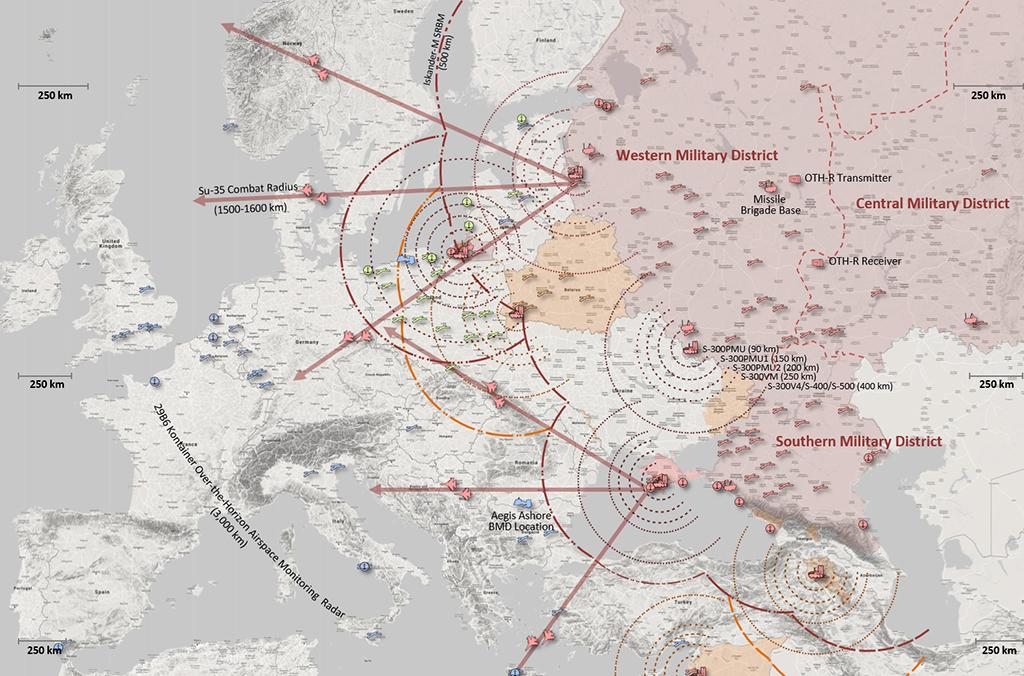
Center For Strategic And Budgetary Assessments Threat Map
There has been much coverage of Russia’s deployment of the SSC-8 ground-launched cruise missile—in violation of the 1987 Intermediate-Range Nuclear Forces (INF) Treaty—and what threat that poses to NATO members. But some analysts think the reaction is overblown, since Moscow already has a huge stockpile of nonviolating weapons that could destroy key sites across Europe from well within its borders.
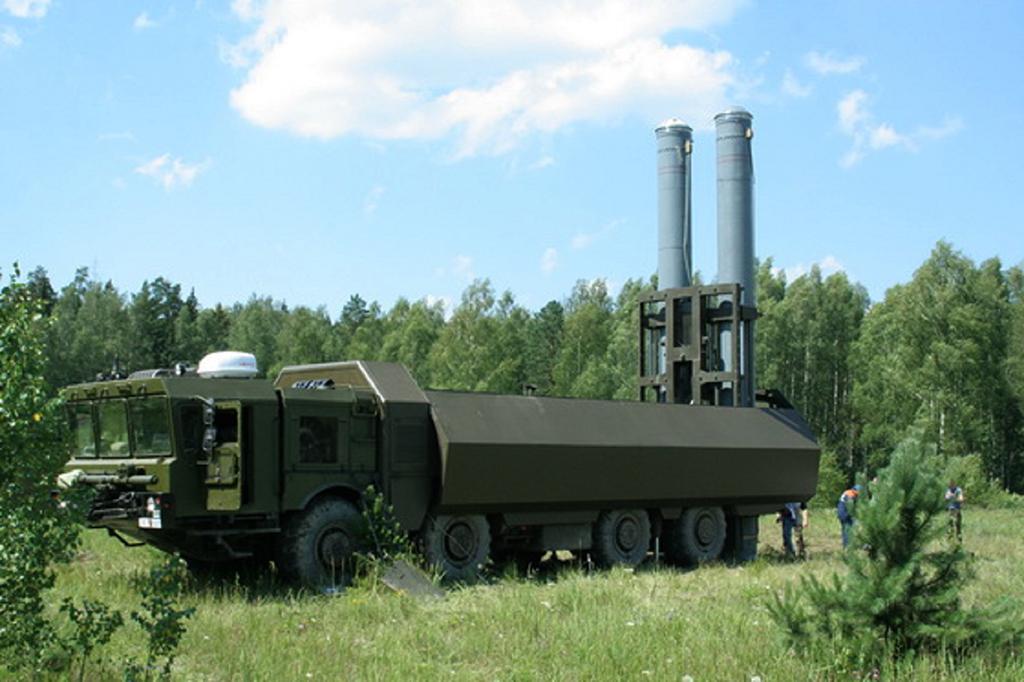
P-800 Oniks Missile
Name: P-800 Oniks (3M55)/SS-N-26 “Strobile” Type: Over-the-horizon supersonic anti-ship missile Coastal Launcher: K-300P Bastion/SSC-5 “Stooge” Manufacturer: NPO Mashinostroyeniya Range: 300 km (160 nm) Speed: Mach 2.5
The P-800 missile was developed in the late 1990s as an advanced, supersonic, ship-killing missile to replace the Soviet-era P-700 Granit series. It entered service aboard the Russian navy’s Nakat-class missile ships, followed by the Bastion coastal defense system in 2015. The manufacturer says it can arm the latest Yasen/Severodvinsk-class submarine, which entered service in 2015. The export variant is called Yakhont.
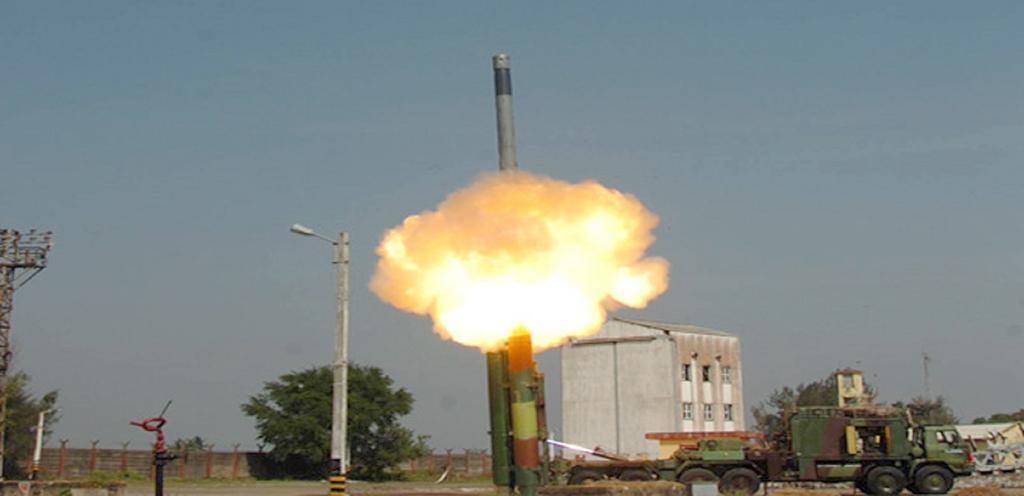
Name: BrahMos Type: Two-stage, high-supersonic cruise missile with solid-propellant booster Launchers: Land, air, sea and undersea platforms, vertical and inclined launchers Manufacturer: Joint venture between Russia’s NPO Mashinostroyeniya and India’s Defense Research and Development Organization Standard Range: 290 km Extended Range: More than 400 km Speed: Mach 2.8 Warhead Weight: 200-300 kg (440-660 lb.)
Introduced by the Indian navy in 2005, the liquid-ramjet BrahMos cruise missile is based on Russia’s P-800 Oniks. The project sets the bar for military cooperation between Moscow and New Delhi, but until recently the missile’s range has been limited by the Missile Technology Control Regime (MTCR), which prohibits signatories from helping nonmembers develop missiles with a range greater than 300 km. India finally joined the MTCR in June 2016 and has wasted no time extending BrahMos’s range. On March 11, the first BrahMos-ER was test fired from the Indian army’s range in Chandipur, Odisha.
A hypersonic derivative, the Mach 7 “BrahMos-2,” is already in development. India is outfitting its Sukhoi Su-30MKI strike fighters with an air-launched version. Russia is still deciding whether to adopt the missile because of its speed, but it has plenty of home-grown alternatives. Export variants of BrahMos are actively marketed around the world.

Name: Iskander-K/R-500 Type: Short-range ground-launched cruise missile Range: Within 500 km, probably more depending on fuel capacity Deployed: 2013
Shortly after the Iskander tactical ballistic missile system was deployed, the Russian military began tinkering with new launching methods for cruise missiles. Testing of the R-500 reportedly began in 2007, and initial deployment was achieved six years later. Images released by the Russian defense ministry in 2014 show what appears to be missiles being erected and fired from the Iskander-M system. The R-500 cruise missile has reportedly been given the designation 9M728 by Russia and SSC-7 by NATO. If deployed from Kaliningrad alongside conventional Iskander units, the cruise missile could reach anywhere within Poland. Lithuania, Latvia, Estonia, Belarus and Ukraine are already within firing range from the Russian border but now face potential attacks from all sides.
Sources: Russian Defense Ministry and Center for Strategic and Budgetary Assessments
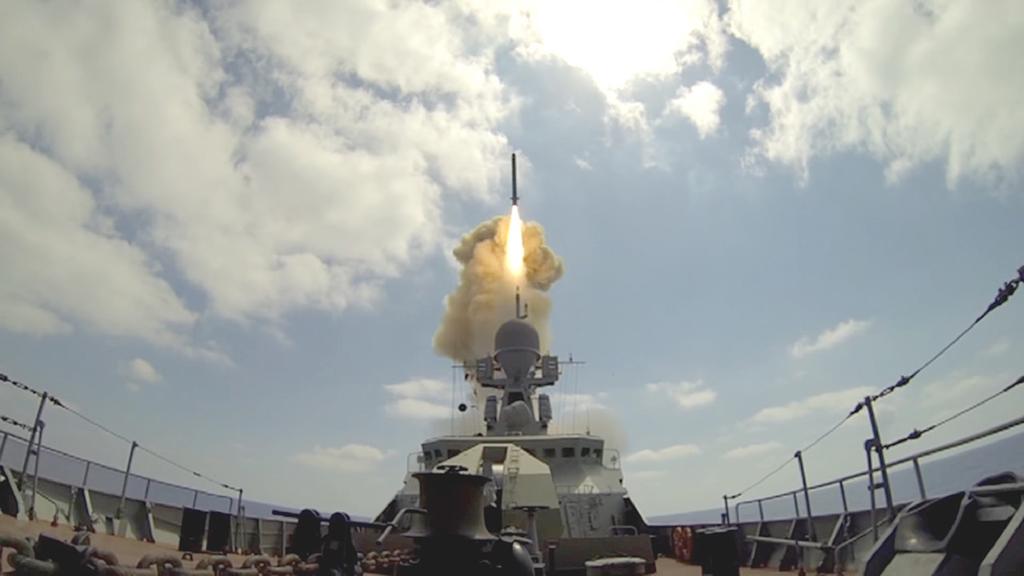
3M14 Kalibr
Name: Kalibr/SS-N-30A Type: Sea-launched anti-ship and land-attack cruise missile Versions: 3M54 (anti-ship), 3M14 (land-attack), “Club” (export) Launch Platforms: Ships (3M54T/3M14T Kalibr-NK), submarines (3M54K/3M14T Kalibr-PL) Launcher: 3S14 Agat vertical launch system Manufacturer: NPO Novator/OKB Warhead: Nuclear or conventional Estimated Range: 1,500-2,500 km (300 km export) Warhead Weight: 450 kg Deployed: 2015
Russia’s family of Kalibr cruise missiles are among its most potent threats. Featuring thrust-vectoring boosters, the 3M14 Kalibr-NK was demonstrated to the world in October 2015 when 26 missiles were fired at land targets in Syria, demonstrating an operational range of at least 1,500 km. Kalibr-class land attack and anti-ship missiles will arm the majority of Russia’s submarines, corvettes, frigates and large surface ships. The range of the exportable “Club-K” variant has been artificially limited for treaty compliance. However, it is capable of being launched covertly from shipping container, trains, trucks or merchant ships.
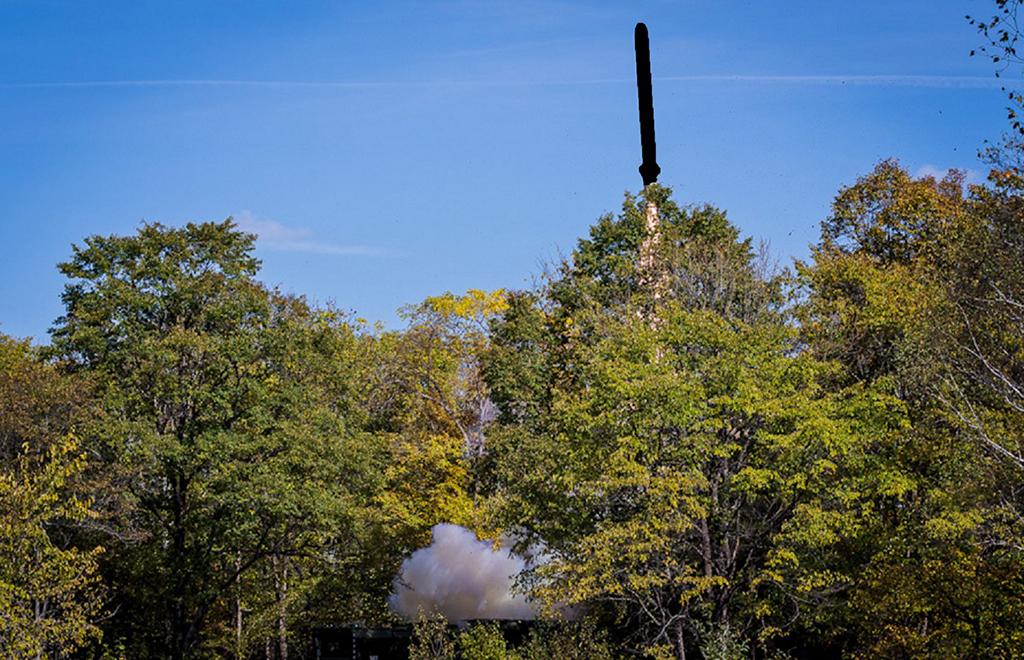
RT-2PM Topol
Name: RT-2PM Topol/SS-25 “Sickle” Type: Road-mobile intercontinental ballistic missile Configuration: Three-stage solid-propellant booster with postboost vectoring Nuclear Warheads: One Maximum Range: 11,000 km (5,940 nm) Deployed: 1988
The RT-2PM Topol entered development in 1977, but technical challenges set the project back, and the weapon was finally adopted for active duty by Soviet forces in 1988. The missile is armed with the 550-kt. “gooseneck” nuclear warhead. The missile is being phased out along with the R-36M2 (SS-18 Satan) and UR-100 (SS-19) missiles to achieve a completely modernized rocket force by 2022. The Topol is being succeeded by the Topol-M (SS-27 Sickle B).
Sources: Russian Defense Ministry and U.S. National Air and Space Intelligence Center

Name: RT-2UTTH Topol-M/SS-27 Sickle B Type: Silo-based and road-mobile intercontinental ballistic missile Configuration: Cold-launched, three-stage solid propellant booster with postboost vehicle Nuclear Warheads: One Guidance: Satellite-aided inertial navigation Maximum Range: 11,000 km (5,940 nm) Deployed: 1997 (silo), 2006 (mobile launcher)
The Topol-M is Russia’s premier modern post-Cold War ICBM, equipped with one warhead each and capable of striking targets anywhere in the U.S. The weapon was first fielded in upgraded SS-19 silos and is also carried by a mammoth mobile launcher. The missile has a launch weight of 47,000 kg and measures 22 m (72 ft.) long and 2 m in diameter at the base. Russia has developed a multiwarhead version, initially reported by the U.S. National Air and Space Intelligence Center under the NATO designation SS-27 Mod-X-2 (experimental). That distinct version is now known as the RS-24 Yars (SS-29).
Sources: Russian Defense Ministry, U.S. National Air and Space Intelligence Center and Center for Strategic and International Studies


RS-26 Rubezh
Name: RS-26 Yars-M/Rubezh or “Frontier”/SS-X-31 Type: Heavy road-mobile intercontinental ballistic missile Configuration: Solid-fuel, multistage missile Derived From: RS-24 Yars Warheads: Multiple (potentially 4-12, independently targetable) Estimated Range: 12,500 km (6,800 nm)
Russia began testing its latest heavy-duty road-mobile ICBM in 2011. The first test reportedly failed, but the second flight in 2012 was declared a success, with the missile hitting its target some 6,000 km away from the launch site. There is speculation that the missile will be armed with maneuvering hypersonic warheads to penetrate advanced Western air defenses. Russian press reports suggest the missile has finished development and is now ready for duty. The RS-26’s deployment alongside the Yars ICBM will allow Moscow to completely phase out its Soviet-era Topol missiles by 2021.
Sources: Russian Defense Ministry, Center for Strategic and Budgetary Assessments and Russia Today
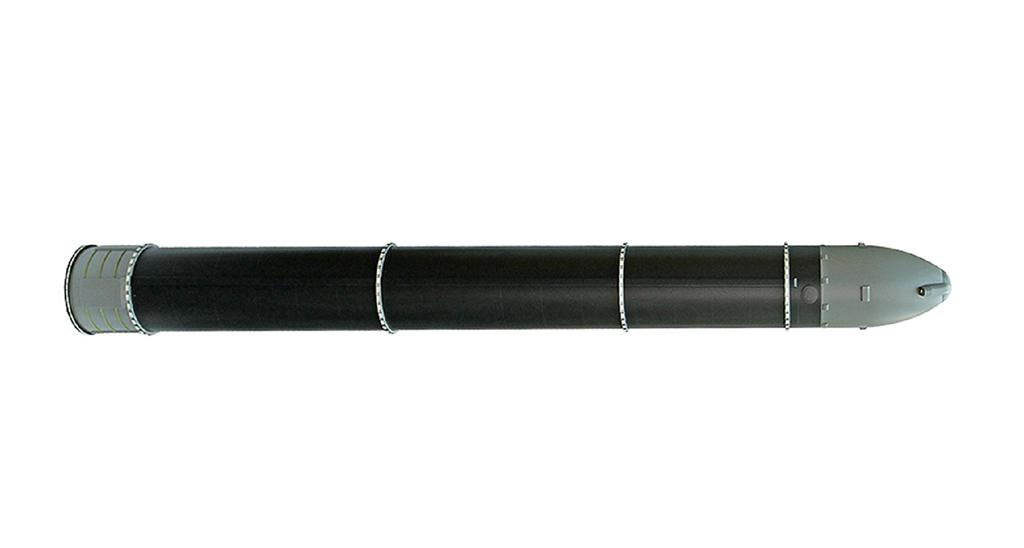
RS-28 Sarmat
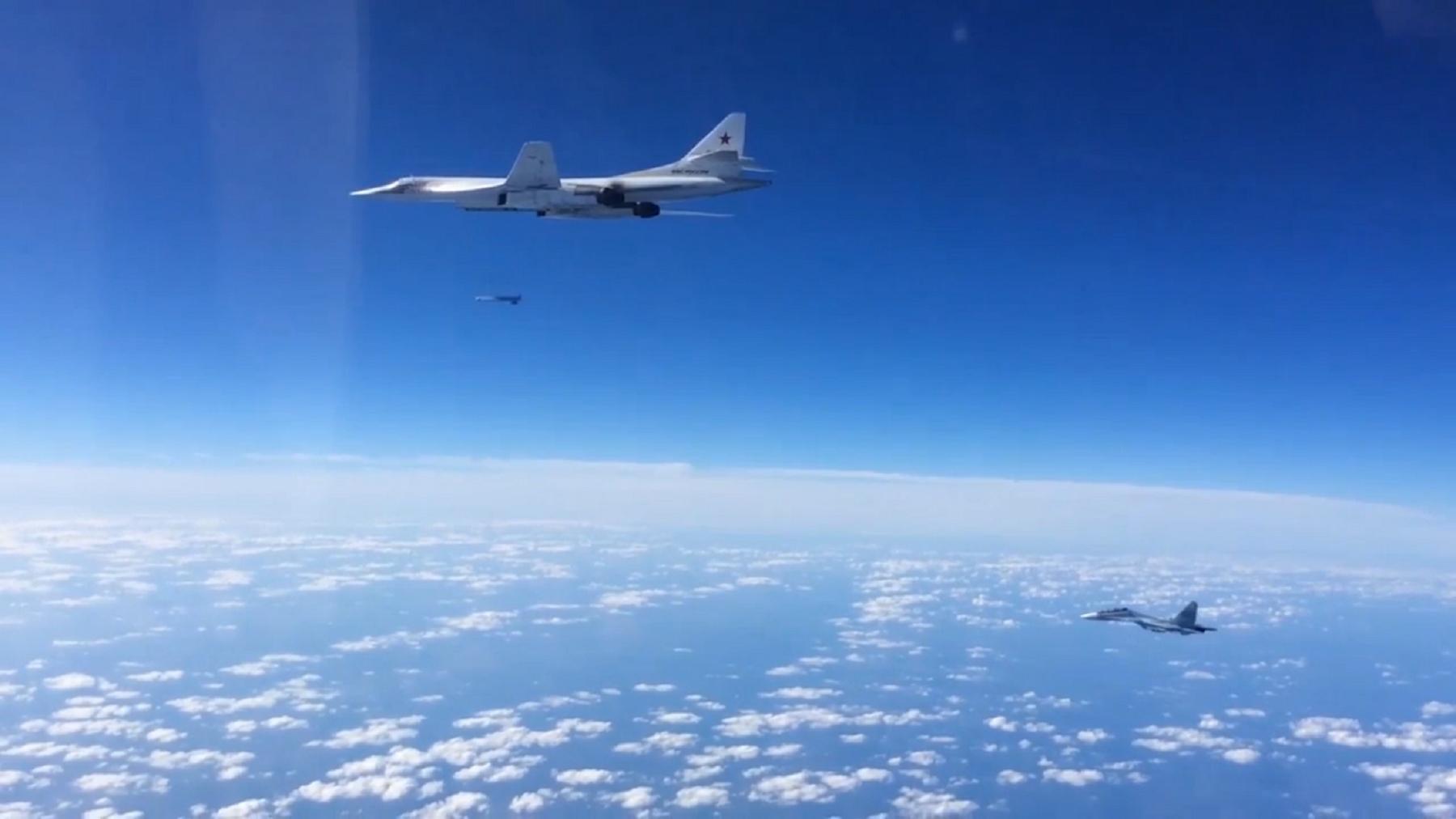
Name: Kh-101/102 Type: Low-observable air-launched cruise missiles Replaces: Soviet-era Kh-55 AS-15 “Kent” cruise missile Launch Platforms: Tupolev Tu-22, Tu-160 and Tu-95 bombers Warheads: Kh-101 (conventional) Kh-102 (nuclear) Estimated Range: 3,000 km Deployed: 2015
The Kh-101/102 long-range air-launched cruise missile reportedly entered development in the late 1990s but was only recently drawn into service to strike land targets in Syria. The first images and videos of Kh-101 missiles being launched operationally from “Bear” and “Blackjack” bombers appeared in late 2015. The missiles have greatly improved range compared to their predecessor, the Kh-55, but estimates vary from 2,500-5,000 km. The missile can carry conventional or nuclear warheads and has low-observable characteristics to penetrate Western air defense systems.
Sources: Center for Strategic and Budgetary Assessments and Russia Today
From land-attack missiles to ballistic behemoths, Aviation Week explores the modern weapons Russia is fielding.

Stay Connected. Stay Informed Grow Your Business.
Arms Control Wonk
In-depth Analysis of 3M Series Kalibr Cruise Missiles
From the russian inventory, an in-depth analysis of 3m series kalibr cruise missiles reveals their remarkable characteristics as advanced, long-range, precision-strike weapons primarily designed for launch from naval platforms, including submarines, surface ships, and coastal defence systems. these missiles have garnered significant attention and acclaim due to their exceptional versatility, unwavering accuracy, and their extensive capability to engage a wide range of targets. operating under the nato reporting names ss-n-27 sizzler and ss-n-30a, this family of russian cruise missiles has been ingeniously developed by the prestigious npo novator design bureau..
Among the well-known variants, the 3M-14 Kalibr-K stands out as it is predominantly utilized by submarines and boasts an estimated range of 2,500 kilometres ( 1,553 miles ). This impressive range empowers the Russian Navy to effectively strike targets located deep inland throughout Central/Western Europe. This family of cruise missiles, similar to the American Tomahawk, first came into service in 1994. The range of subsonic versions is larger than that of supersonic ones. Additionally, some versions incorporate a second propulsion stage that initiates a supersonic sprint in the terminal approach to the target, thereby reducing the time available for the target’s defence systems to react.
The missile possesses the capability to carry either a thermonuclear warhead or an explosive payload weighing up to 500 kilograms ( 1,100 lb ). These missiles are frequently launched in salvos, which involve firing multiple missiles simultaneously. This strategic approach allows for coordinated attacks, significantly increases the likelihood of target destruction, and poses challenges to enemy defences. The 3M series Kalibr missiles employ a combination of guidance systems to ensure accurate targeting. They utilize inertial navigation systems, satellite guidance, and mid-course updates to adjust their trajectory and reach the intended target. Some variants may also incorporate terminal active radar homing or electro-optical seekers to enhance precision during the final stages of flight.
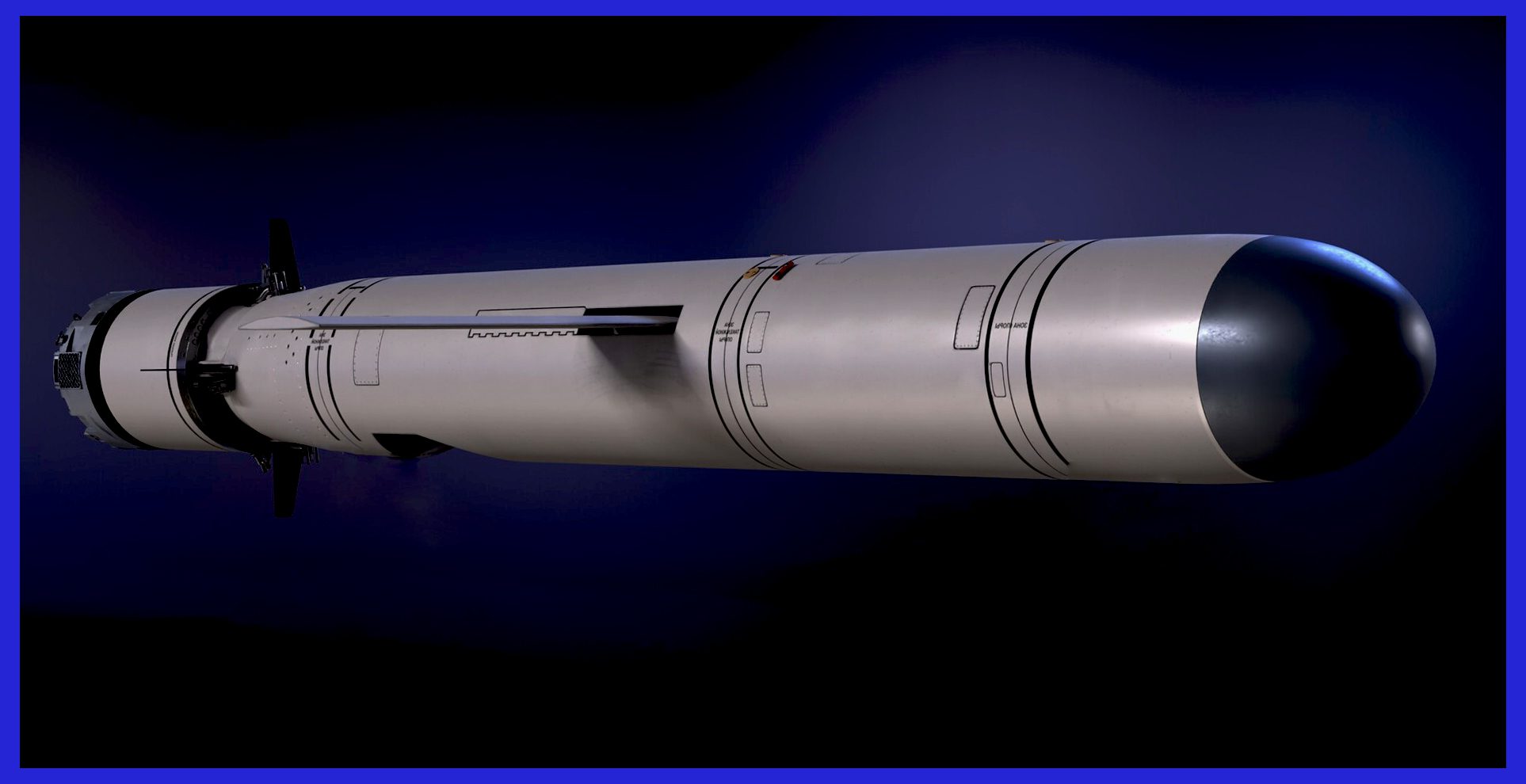
The Concept Behind the Development of the 3M Series Kalibr Cruise Missiles:
The development of the 3M series Kalibr cruise missiles began in the late 1990s by the Novator Design Bureau, with the goal of creating versatile and effective naval cruise missiles for the Russian military. These missiles incorporated advanced technologies, such as reduced radar cross-section and low observable characteristics, enhancing their ability to evade enemy defences. Russia plans to deploy KALIBR capability on newly designed submarines, corvettes, frigates, and larger surface ships, providing even modest platforms with significant offensive capability.
With the land attack missile , these platforms can engage distant fixed-ground targets using conventional warheads. Extensive testing and evaluation were conducted to verify the performance and reliability of the 3M series Kalibr cruise missiles, including land-based and sea-based tests to assess flight characteristics, range, accuracy, and effectiveness against various targets.
Over time, the development efforts resulted in the production of different variants of the 3M series Kalibr cruise missiles, each optimized for specific launch platforms and mission requirements. These variants included versions for submarines, surface ships, coastal defence systems , and even air-launched variants for deployment on Russian strategic bombers .
An In-Depth Analysis of the Kalibr Cruise Missile Design:
The Kalibr cruise missile design is a state-of-the-art sophisticated system of the latest generation that incorporates various technological advancements to achieve its capabilities.
Airframe and Propulsion: The Kalibr cruise missile features a streamlined airframe designed to minimize drag and increase aerodynamic efficiency. The sleek cylindrical shape reduces radar cross-section . The airframe is typically constructed using composite materials to ensure strength while keeping the overall weight low. The missile is propelled by a multi-stage solid-fuel rocket motor for the 91RE1/RTE2 versions, which provides high thrust and acceleration, and a turbojet engine for the 3M-54/E/TE/E1/TE1, 3M-14/E/TE versions. The propulsion system allows the missile to achieve the required speeds for efficient cruising and manoeuvring during flight.
Guidance and Navigation: The Kalibr cruise missile utilizes an advanced guidance and navigation system to ensure precise targeting. Some variants may incorporate terminal guidance capabilities, such as active radar homing or electro-optical seekers, to enhance accuracy during the final stage of the mission. When approaching the intended target, both the Russian domestic variant ( 3M54T / 3M54K ) and export variants ( 3M54TE / 3M54KE ) are capable of achieving supersonic speeds ( Mach 3.0 ) while maintaining sub-sonic speeds. These missiles also possess exceptional manoeuvrability, executing high-angled defensive manoeuvres that deviate from the typical linear flight path observed in other anti-ship cruise missiles .
To autonomously navigate during flight, the missile relies on an inertial navigation system (INS). This INS employs gyroscopes and accelerometers to accurately measure changes in velocity and direction. Additionally, the missile incorporates terminal active radar homing. Furthermore, satellite-based navigation systems like GLONASS, the Russian global navigation satellite system, are employed for precise positioning and mid-course phase updates. The incredible terminal speed of these missiles poses a significant challenge for modern defence systems attempting to repel them, and their remarkable precision renders them highly lethal against mobile targets such as destroyers.
Versions and Launch Platforms: The missile comprises five modular versions: two for anti-shipping purposes, one for land attack, and two for anti-submarine operations. The design of the missile allows for shared components between surface-launched and submarine-launched variants, although each missile possesses distinct elements, such as the booster. When launched from a surface ship, the missile can utilize a vertical launching system (VLS) and is equipped with a booster featuring thrust vectoring capability. Conversely, when launched from a submarine’s torpedo tube, the missile does not require such an addition but instead employs a conventional booster. As for the air-launched version , it is enclosed within a container that is subsequently released as the missile launches, effectively separating from the container.
The ‘Club-K’ is a Russian container complex of missile weapons that are housed in standard 20- and 40-foot sea containers . This system is specifically designed to engage surface and ground targets effectively. The versatile nature of the complex allows it to be installed on shorelines, vessels of various classes, rail platforms, and trucks. It is essentially a modified version of the Kalibr missile system. In 2010, a variant of the Club-K was introduced, which features a clever disguise as a shipping container.
This containerized variant can be easily placed on trucks, trains, or merchant vessels. The Club-K in a shipping container form was publicly showcased for the first time at the MAKS 2011 air show. By incorporating the launcher system within a standard shipping container, the missiles can be transported and stored discreetly without raising suspicion. This covert capability poses significant challenges for pre-emptive strikes against the launcher, as its true nature and intent remain well-concealed.

Naval application: The Kalibr missiles are launched from various Russian submarines, including the Kilo class, Lada class, Amur class, Akula class, Yasen class, and Borei class. Additionally, low displacement platforms equipped with the Kalibr system include the Russian Gremyashchy class, Buyan-M class, the second batch of Steregushchy class corvettes, and the Karakurt class. Russian frigates of the Gepard, Admiral Gorshkov, and Admiral Grigorovich classes are also capable of carrying these missiles. Furthermore, the Indian Talwar class frigate serves as another ship-borne launch platform for the Club missile system. There are indications that a variant for air launch may be developed to arm the Tu-142s , which are currently deployed by the Russian Navy.
Range and Performance: The range of the 3M series Kalibr cruise missiles varies depending on the specific variant and launch platform. The widely recognized variant, known as the 3M-14/3M-14T, boasts an estimated range of approximately 1,500 to 2,500 kilometres ( 932 to 1,553 miles ). This particular variant finds primary use on surface ships and submarines. On the other hand, the 3M-54 Kalibr and 3M-54E Kalibr variants also referred to as Klub, possess a range of around 220 to 300 kilometres ( 137 to 186 miles ) and are typically deployed for land-attack missions.
According to a state television news broadcast on 11th October 2015, the production of the Kalibr-PL missile, a submarine-specific derivative of the 3M14TE Kalibr-NK, commenced in 2012. This version boasts specifications including a top speed of Mach 3, a range of 4,000 kilometres, and the ability to operate in various environments: air, land, water, and underwater. The missile has a minimum operating height above the terrain of 10 meters, with an average height ranging from 20 to 50 meters ( up to 1000 m ).
It features automatic terrain following and in-flight controllability, allowing it to perform 147 or more manoeuvres in any direction. The design bureau has enhanced the targeting system of the Kalibr cruise missile, enabling it to execute time-sensitive attacks over extended distances from both ships and submarines.
Warhead placement: The 3M series Kalibr missiles are equipped with various types of warheads depending on their intended targets. Anti-ship variants, like the 3M-54E, commonly utilize a high-explosive fragmentation warhead specifically designed to cause substantial damage to surface ships. Land-attack variants, such as the 3M-14, utilize a conventional warhead with an estimated weight of approximately 450 kilograms (992 pounds). Moreover, the 3M-14/3M-14T versions can be equipped with either a thermonuclear or conventional warhead in domestic land-attack variants.
Testing and Evaluation: Since its inception in 1994, the Kalibr cruise missile has undergone extensive testing and evaluation during the development and production phases. The testing process encompasses ground-based trials, flight tests, and live-fire exercises to validate its performance, reliability, and accuracy. The missile’s flight characteristics, range, accuracy, and lethality are assessed under various operational conditions and scenarios. Notably, during the Russian military intervention in the Syrian civil war, the Kalibr missile was utilized to neutralize key targets, providing an opportunity to thoroughly evaluate its overall performance and missile characteristics.
Variant Configurations: Exploring the Different Versions of the 3M Series Kalibr Cruise Missiles
The 3M series Kalibr cruise missiles have various variant configurations that cater to different launch platforms and mission requirements. Let’s explore the different versions of the 3M series Kalibr cruise missiles in more detail:
Russian variants _
- 3M54K: The 3M54K is a submarine-launched anti-shipping variant designed specifically for deployment by the Russian Navy. It is widely known and extensively used. The missile has a length of 8.22 meters ( 27.0 feet ) and is equipped with a 200 kg (440 lb) warhead. Its estimated range is between 550 and 660 kilometres ( 340-410 miles ). The 3M54K is a sea-skimmer missile that maintains a final stage flight altitude of 4.6 meters ( 15 feet ) and achieves a supersonic terminal speed of Mach 2.9 ( 3,550 km/h; 2,210 mph ).
- 3M54T: The 3M54T is an anti-shipping variant deployed by the Russian Navy on surface ships. It is launched using a Vertical Launch System (VLS) and features a thrust vectoring booster. The missile measures 8.9 meters (29 feet) in length. It shares the same warhead weight and performance characteristics as the 3M-54K variant.
- 3M14K (SS-N-30A): The 3M14K is an inertial guidance land attack variant deployed by the Russian Navy. This submarine-launched weapon has a base length of 6.2 meters (20 feet) and is equipped with a 450-kilogram (990-pound) warhead. With a range of 2,500 kilometres (1,600 miles), it enables the Russian Navy to target locations throughout Central/Western Europe from beyond the GIUK gap. The missile achieves a subsonic terminal speed of Mach 0.8.
- 3M14T: The 3M14T is the inertial guidance land attack variant deployed by the Russian Navy. It is a surface ship-launched missile with a vertical launching system (VLS) and a thrust vectoring booster. The missile has a basic length of 8.9 meters (29 feet), and its warhead weight and other performance characteristics are identical to those of the 3M14K.
- Kalibr-M: The Kalibr-M is a new version of the Kalibr missile system that features a larger warhead and an extended range of up to 4,500 kilometres (2,796 miles). Currently, the ship-launched, submarine-launched, air-launched, and land-launched versions of the Kalibr-M are under development.
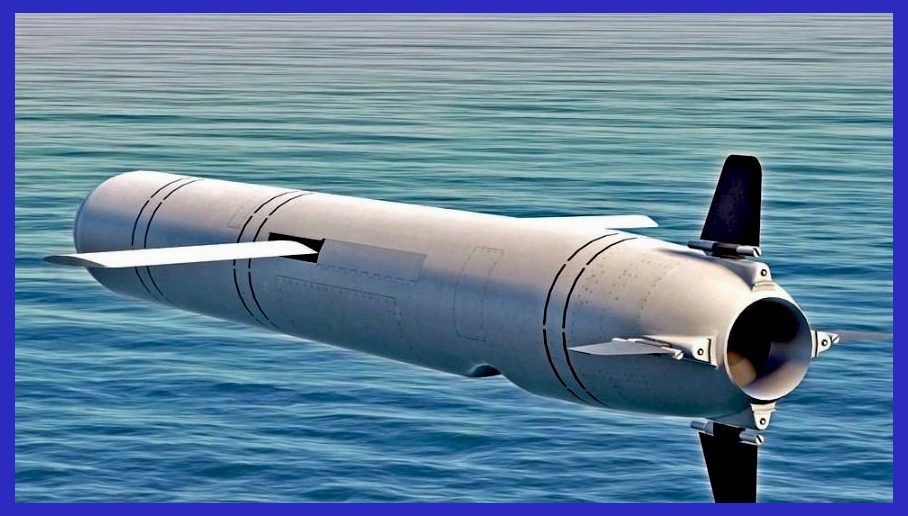
Export Variants: The export models are designated under the Club category.
- 3M-54E: is the submarine-launched anti-shipping variant. It has a basic length of 8.2 m (27 ft) and is equipped with a 200 kg warhead. The range of this variant is 300 km. It operates as a sea skimmer, reaching a supersonic terminal speed of Mach 3.0 and maintaining a flight altitude of 4.6 meters (15 ft) during its final stage.
- 3M-54E1: is a submarine-launched anti-shipping variant. It has a basic length of 6.2 m (20 ft) and is equipped with a 200 kg (440 lb) warhead. The range of this variant is 300 km (190 mi). It operates as a sea skimmer, with a subsonic terminal speed of Mach 0.8.
- 3M-14E: is an inertially guided land attack variant launched from a submarine. It has a basic length of 6.2 m (20 ft) and is equipped with a 450 kg (990 lb) warhead. The range of this variant is 300 km (190 mi). It operates at a subsonic terminal speed of Mach 0.8.
- 3M-54TE: is a surface vessel-launched anti-shipping variant equipped with VLS (Vertical Launch System) and a thrust vectoring booster. Its basic length is 8.9 m. It shares the same warhead weight and performance characteristics as the 3M-54E variant. However, its range is shorter compared to the 3M-54. It operates as a sea skimmer with a supersonic terminal speed and a flight altitude of 15 feet (4.6 m) during its final stage. At that stage, it achieves a speed of Mach 3 and has a range of 220 km (140 mi) at supersonic speed.
- 3M-54TE1: is a surface ship-launched anti-shipping variant equipped with VLS (Vertical Launch System) and a thrust vectoring booster. It has a basic length of 8.9 m (29 ft), and its warhead weight and other performance characteristics are identical to the 3M-54E1 variant. It operates as a sea skimmer with a subsonic terminal speed of 0.8 Mach.
- 3M-14TE: is an inertially guided land attack variant. It is launched from a surface ship with VLS (Vertical Launch System) and features a thrust vectoring booster. The basic length of the missile is 8.9 m (29 ft), and its warhead weight and other performance characteristics are identical to the 3M-14E variant. The missile operates at a subsonic terminal speed of 3.0 Mach, with a range of 300 km (190 mi) at supersonic speed.
The land-based anti-ship variant 3M-54E2 and the land-attack variant 3M-14E1 are part of a self-propelled missile system designed for coastal defence. Both missile variants in the system arsenal have a weight of 1,700 kg and are equipped with a 450 kg warhead. They are capable of achieving a flight speed of 240 m/s. According to the manufacturer, NPO Mash, when operating in land-attack mode, the system has a Circular Error Probable ( CEP ) of 50 m in the export version.
Club-A _ ( It is intended to be launched from bombers such as Tu-22M3 , Tu-160 , and Tu-95 )
- The 3M-54AE is an air-launched anti-ship derivative of the missile. It consists of two phases and achieves supersonic speed at the end. The missile weighs 1950 kilograms and is equipped with a 200-kilogram warhead. It has a range of 300 kilometres.
- The 3M-14AE is an air-launched land attack variant specifically designed for aerial operations. It operates at a subsonic speed and utilizes INS+satellite guidance for precise targeting. The missile has a length of 6.2 meters and weighs 1400 kilograms. It is equipped with a 450-kilogram warhead and has a range of 300 kilometres.
These variant configurations of the 3M series Kalibr cruise missiles offer adaptability and versatility for various launch platforms and mission scenarios. They provide Russia with the capability to engage a wide range of targets, including both land-based and surface targets, from submarines, surface ships, and potentially strategic bombers. It is worth noting that the Kalibr missile family may include additional versions or upgraded configurations that have been developed or may be developed in the future. These variants reflect the continuous efforts of the Russian military to enhance its cruise missile capabilities and maintain a credible strategic deterrent.
Operational Triumphs of the Kalibr Cruise Missile:
Combat Operations in Syria: The Kalibr cruise missile made its combat debut during the Russian military intervention in Syria from 2015 until 2018. Russian naval vessels, including submarines and surface ships in the Caspian and Mediterranean Seas, launched Kalibr missiles against targets in Syria. The missiles were used to strike various targets, including terrorist infrastructure, command centres, ammunition depots, and militant positions. The Kalibr cruise missiles showcased their precision and long-range capabilities, enabling Russia to effectively strike targets in Syria from significant distances.
Combat Operations in Ukraine: February 2022 – Present (June 2023): Kalibr cruise missiles have been extensively utilized by Russian forces since the commencement of the 2022 Russian invasion of Ukraine on 24th February 2022. The initial offensive reportedly involved a minimum of 30 cruise missiles, which targeted command and control centres, air bases, and air defence batteries. The missiles were likely launched from the Russian Black Sea Fleet’s corvettes, frigates, and Kilo-class submarines. It is estimated that this resulted in the destruction of approximately 80% of Ukraine’s energy sector as of 2023.
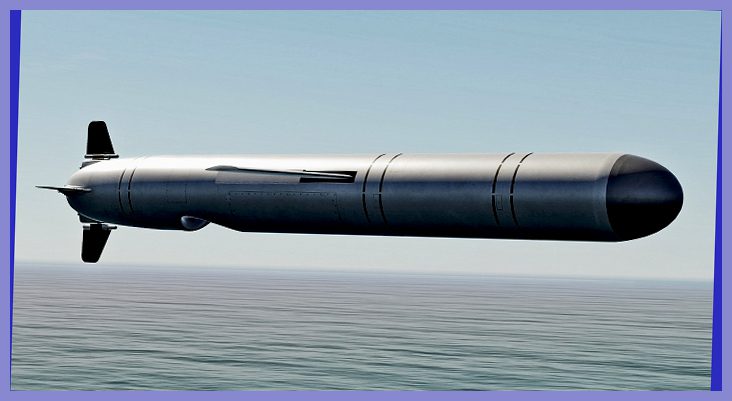
Technical Specifications Of The Kalibr Cruise Missile :
- Weight : the Kalibr cruise missile varies across different variants, ranging from 1,300 kg to 1,780 kg to 2,300 kg
- Length : Varies on the variant, from 6.2 m to 8.9 m
- Diameter : 21 inches
- Wingspan: 8 ft ( 2.43 m )
- Warhead : high explosive (HE) or thermonuclear warhead weighing between 400–500 kg
- Detonation : Various impact fuze options
- Engine : Missile utilizes a multi-stage solid-fuel rocket booster to achieve the required altitude and speed. Afterwards, a turbojet engine is initiated for variants such as 3M-54/E/TE/E1/TE1 and 3M-14/E/TE. However, the 91RE1/RTE2 versions rely solely on solid-fuel rockets for propulsion
- Range : 91RE1: 50 km, 3M-54/3M-54T: 660 km (domestic anti-ship version , estimate) 3M-14/3M-14T: 1,500–2,500 km (domestic land-attack version, estimate) 3M-54E (export anti-ship version): 220 km 3M-54E1/3M-14E (export anti-ship version): 300 km Kalibr-M (under development): 4,500 km
- Flight altitude: 50–150 meter AGL(above ground level) And 20 meter over water
- Flight ceiling: max 1,000 meters AGL
- Speed : Varies on the variant, from 0.8–2.5–3.0 Mach
- Guidance system : Inertial guidance plus terminal active radar homing, by GPS
- Launch Platform: naval ships, submarines, containers, bombers & TEL( transporter erector launcher)

Furthermore, seize the exclusive opportunity to acquire these exquisite large-scale 1/72 premium die-cast models of the formidable SR-71A Blackbird . These remarkable and iconic military reconnaissance jets, which were the fastest and most advanced spy planes ever built during the intense Cold War era, are now available for purchase on AirModels with worldwide delivery. Don’t miss out on this chance to own these exceptional and meticulously crafted models that capture the essence of aviation history. Click here now to secure your piece before the limited stock runs out.
In conclusion, the Kalibr cruise missile is a highly advanced weapon system that has demonstrated remarkable operational success. It incorporates cutting-edge features such as a streamlined airframe, efficient propulsion, advanced guidance systems, and versatile warhead options. The missile can be launched from submarines, surface ships, and potentially strategic bombers, offering operational flexibility in diverse mission scenarios. In addition to Russia, countries such as Algeria, Vietnam, China, Iran, and India also operate this system.
During combat operations in Syria, the Kalibr cruise missile showcased its precision, long-range capabilities, and effectiveness against various targets. Its extended range and stealthy characteristics enhance its ability to engage targets discreetly. With reduced collateral damage, the missile serves as a formidable tool for power projection, deterrence, and precise strikes. The Kalibr cruise missile has become a critical asset in Russia’s naval strike capabilities, underscoring the ongoing advancements in missile technology for modern warfare.
Important Announcement for Our Valued Readers!
After an article is published, it is possible that updates or changes may have occurred beyond the time of publication. Therefore, it is important to be aware that certain information in the article might be outdated. To ensure the most accurate analysis, it is highly recommended to verify the content with the latest sources available.
However, we are dedicated to delivering outstanding articles on military products and global updates. Maintaining quality and smooth operation requires resources. Your support sustains our efforts in providing insightful content. By purchasing high-quality products through our affiliated links, you help us keep our platform alive and acquire top-notch items. Your unwavering support is invaluable and inspires us to strive further.
We welcome your suggestions and requests for more information, as we value feedback from our readers. If there’s specific defence material or equipment not covered on our site, please share your request in the comments. We’ll strive to research and provide the required information. We sincerely thank you for your unwavering interest in our website, and we eagerly anticipate hearing from you! Enjoy your reading experience!
Leave a comment Cancel reply
Save my name, email, and website in this browser for the next time I comment.
Russia is using its newest and oldest missiles indiscriminately against Ukraine
- Russia has been lobbing missiles into Ukraine throughout its five-month war on its smaller neighbor.
- Moscow is using its whole inventory for that assault, firing Soviet-era and newer-model missiles.
- Those missiles have been used in strikes all across Ukraine, on military and civilian targets alike.

Among the most important weapons in the Russian arsenal during its war against Ukraine have been its cruise and short-range ballistic missiles.
Those missiles can reach all of Ukraine, enabling Russia to strike important military infrastructure, especially in western Ukraine, where Western weapons and equipment are being delivered.
Russia has launched thousands of missiles its attack began in February. Although its inventory includes a number of modern missiles capable of precision strikes, Moscow is also lobbing older, less accurate Soviet-era munitions into Ukraine.
Sea-launched
Many of the Russian missiles used in Ukraine have been launched from ships or submarines — the 3M-14 Kalibr cruise missile is easily the most well known.
Designated by NATO as the SS-N-30A, the "Kalibr" family of missiles includes anti-ship, anti-submarine, and land-attack variants that can be launched from ships, subs, and aircraft.
Kalibrs can conduct precision strikes using satellite navigation and have a range of 1,000 to 1,500 miles. They can carry a nearly 1,000-pound conventional high-explosive warhead and are often compared to the US-made Tomahawk cruise missile.
The Kalibr is one of the newest and advanced additions to the Russian missile arsenal, formally entering service in 1994. It first saw action in October 2015, when Russian warships in the Caspian Sea fired 26 Kalibrs at targets in Syria some 1,100 miles away.
The Russian Navy has also been using the P-800 Oniks anti-ship cruise missile. Designated the SS-N-26 "Strobile" by NATO, it has a nearly 200-mile range and a top speed of about Mach 2. Its warheads range from 440 pounds to 550 pounds depending on its mission.
In service since 2002, Oniks missiles are mainly launched from ships and submarines. In 2015, the Russian Navy officially adopted the Bastion mobile coastal defense missile system , enabling Oniks launches from mobile ground-based platforms.
The Kalibr missile's precision has worried NATO commanders . The missile's circular error probability — the radius of the circle in which 50% of its strikes are likely to hit — is estimated to be less than 20 feet. For the Oniks, it's estimated to be less than 5 feet.
Ground-launched
Russia's ground-launched SRBMs have had an extremely important role in the war, particularly the Tochka-U and Iskander-M missiles. Known to NATO respectively as the SS-21 Scarab and SS-26 Stone, they represent the past and present of Russian SRBMs.
Related stories
The Tochka-U was introduced in 1989, improving on the Tochka missile that entered Soviet service in 1975. Fired from a mobile transporter-erector-launcher, the Tochka-U has a range of 75 miles and can carry a 1,000-pound high-explosive warhead, a fragmentation warhead, or a 100-kiloton nuclear warhead.
A Tochka-U's TEL takes 16 minutes to prepare for launch. It can be loaded with another missile in about 20 minutes. The TEL itself also features nuclear, biological, and chemical filtration systems for its crew.
Introduced as a replacement to the Tochka-U in 2006, the Iskander-M has a 250- to 310-mile range and can carry high-explosive warheads of between 1,060 pounds and 1,540 pounds. It can also carry thermobaric warheads, fragmentation warheads, nuclear warheads, or earth-penetrating warheads.
Iskander-Ms are launched from a TEL that can carry two missiles. The TEL itself, which can also be fitted with launch tubs for cruise missiles, is hardened against nuclear, biological, and chemical attacks.
The Tochka-U has a circular error probability of about 300 feet, while the Iskander-M has a CEP of 6 feet to 16 feet.
Air-launched
Russia has been denied control of the air over Ukraine, but it has continuously fired air-launched cruise missiles at Ukrainian targets. The newest of those missile, which the Russians are keen to boast about, are the Kh-101 cruise missile and Kh-47M2 Kinzhal hypersonic missile.
The Kh-101 was introduced in 2012 and has a range 1,500 to 1,700 miles. It can carry a 990-pound high-explosive warhead or be outfitted with fragmentation or nuclear warheads. Satellite navigation and an onboard computer allow it to perform precision strikes with a CEP reportedly as small as 20 feet.
The Kinzhal is one of Russia's newest and most advanced weapons and one of the few hypersonic missiles in service.
Launched from a modified MiG-31 interceptor or strategic bomber, the Kinzhal has a range between 1,000 miles and 1,200 miles and can carry a warhead of more than 1,000 pounds. It can reportedly reach speeds of about Mach 10, and like other hypersonic missiles, it can maneuver in flight, making it virtually impossible to intercept.
The Kinzhal became the first hypersonic weapon to be used in combat on March 18, when Russian aircraft launched several of them at an underground depot in western Ukraine. Three more Kinzhals were reportedly used in strikes against Odessa on May 9.
Russia has also used less advanced Soviet-era air-launched missiles, namely the Kh-22 anti-ship missile — introduced in 1968 to take out aircraft carriers — and the Kh-55 cruise missile introduced in 1984.
The Kh-22 has a range of nearly 400 miles and a 2,000-pound warhead, while the Kh-55 has a range of over 1,500 miles and a 900-pound warhead. Neither are terribly accurate; the Kh-22's CEP is estimated to be more than 300 feet and the Kh-55's is estimated to be about 80 feet. An updated version of the Kh-22, the Kh-32 , has improved range and payload.
Battlefield effects
Overall, Russian missile strikes have had a tremendous effect on the Ukrainian war effort. Videos of Kalibrs being launched from Russian surface ships and submarines , and of Kalibrs flying over Ukraine and hitting targets have emerged throughout the conflict.
Russian SRBMs fired from Belarus and Russia have hit military bases and airfields , while Tu-22M, Tu-95, and Tu-160 bombers have reportedly launched missiles at similar targets while flying over Belarus and the Black Sea to avoid Ukrainian air defenses.
The strikes have made it difficult for the Ukrainian Air Force to operate from airfields and have reportedly targeted Western weapon shipments. Ukrainian recruits are now training as far away as Britain to avoid being attacked.
Russia's missiles also routinely hit civilian areas — including a Tochka-U strike on a railway station in Kramatorsk on April 8 that killed 59 civilians (including seven children) and a Kh-22 strike on a shopping mall in Kremenchuk on June 27 that killed 20 civilians. Russian denials about both cases have been debunked.
Russia's use of less sophisticated missiles like the Kh-22 and Tochka-U, and the use of anti-ship missiles like the Kh-22 and P-800 against Ukrainian ground targets may indicate that Moscow is having difficulty replenishing its stocks of more modern precision weapons.
Watch: VIDEO: Why Russia's military is failing so far in Ukraine
- Main content
- Click here - to use the wp menu builder

It is regarded as an essential and distinguished capability for a naval power to have the ability to attack long-distance strategic targets located in the depths of the land. Until 2015, it was thought that only the USA and Britain had this capability since they had Tomahawk cruise missiles. However, the United States and the United Kingdom are no longer the only nations with long-range cruise-missile engaging capability.
On October 7, 2015, the Russian Gepard-class frigate Dagestan and three small Buyan-class corvettes sailing in the Caspian Sea launched twenty-six Kalibr cruise missiles from the Vertical Launch Systems. The nine-meter-long cruise missiles flew up nine hundred miles over Iranian and Iraqi territory before slamming into targets into eleven targets in Syria, hitting a mix of ISIS fighters and Free Syrian Army rebels.
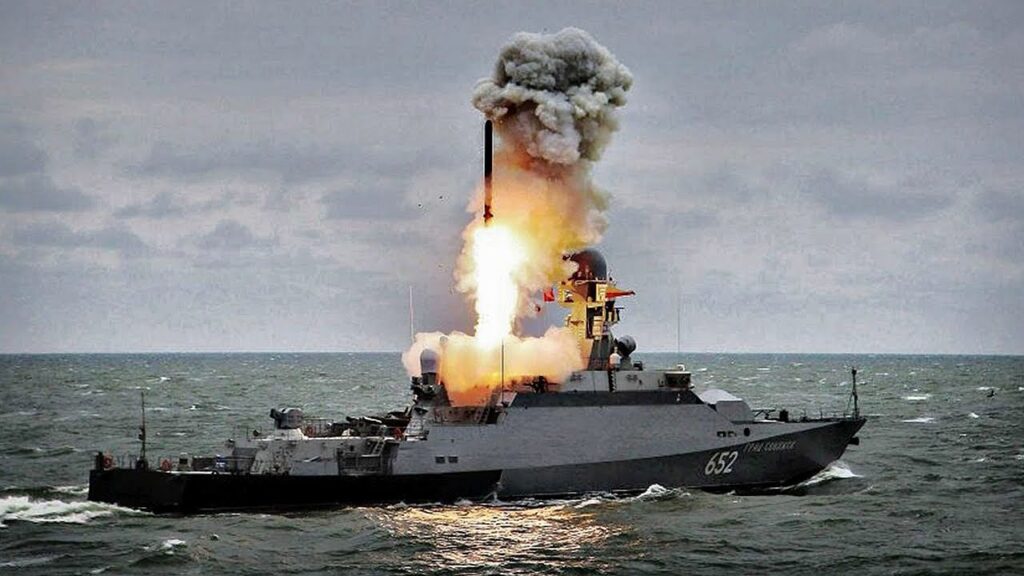
Kalibr missiles are currently deployed on Russian Navy Kilo-class submarines and more modern types, including the Akula, Lada, and Yasen classes. They are also deployed on frigates and corvettes—but so far have not been fitted on larger vessels, though such upgrades may eventually take place. While a Russian Gepard-class frigate is armed with only eight Kalibr missiles, a missile-armed destroyer would be able to carry dozens .
There are well over a dozen different variants in the Kalibr missile family, varying in launch platform, range, target profile, and speed, varying in length from six to nine meters, but all packing a 990-pound warhead or a nuclear payload. The land-attack variants, the 3M14T and 3M14K (NATO designation SS-N-30A) appear to lack the boost to Mach 3 on terminal approach. In compensation, the inertia-guided missiles have a range of between one thousand and 1,500 km. Guidance is ins, GPS, and digital scene matching area correlation (DSMAC), whereby images are taken during the flight by an onboard camera for comparison with stored ones. The Russian Navy has been planning to upgrade 3M14 “Kalibr” cruise missile with a longer-range “Kalibr-M” variant with a maximum firing range of more than 4,500 km.
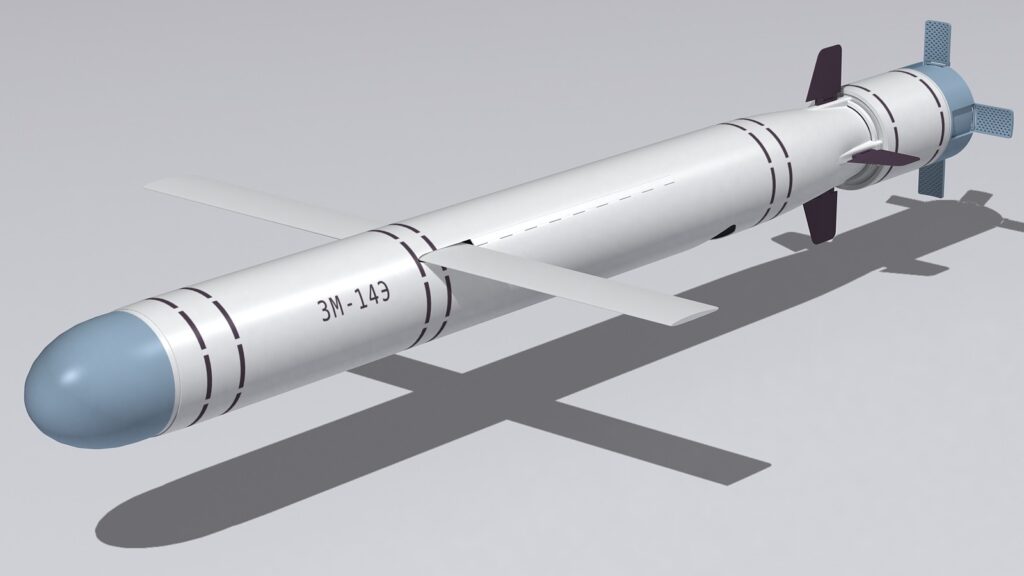
The Tomahawk (Land Attack Missile (TLAM) is a long-range, all-weather, subsonic cruise missile primarily used by the United States Navy and Royal Navy. Tomahawk cruise missile is capable of navigation by an inertial navigation system, GPS enabled precision strike, flies at very low altitude, and reprogrammable during flight to change target.
Guidance is GPS, Ins, terrain contour matching (TERCOM) navigation. This system compares the terrain underneath the cruise missile with mapping data stored inside the missile to detect deviations from its nominal trajectory.15 alternative pre-programmed targets can be held before flight or acceptance of a new target in-flight, delay and loiter option, battle damage assessment via two-way data link.
Tomahawk missile can take reconnaissance pictures after reaching a designated area and send them to the HQ via SATCOM and wait for their instructions. It can be loitered until the target is ‘clear to engage.’ With DSMAC (Digital Scene Mapping), a picture of a discrete target can be uploaded in a confined region and have Tomahawks specifically find and hunt them down.
With the modification Block V , Tomahawk has increased capabilities, which integrate new seeker, hitting the surface targets, more than 1000 miles range, greater penetrating power, less susceptible to jamming of its seeker and communication and navigation striking the target under the GPS taken down conditions.
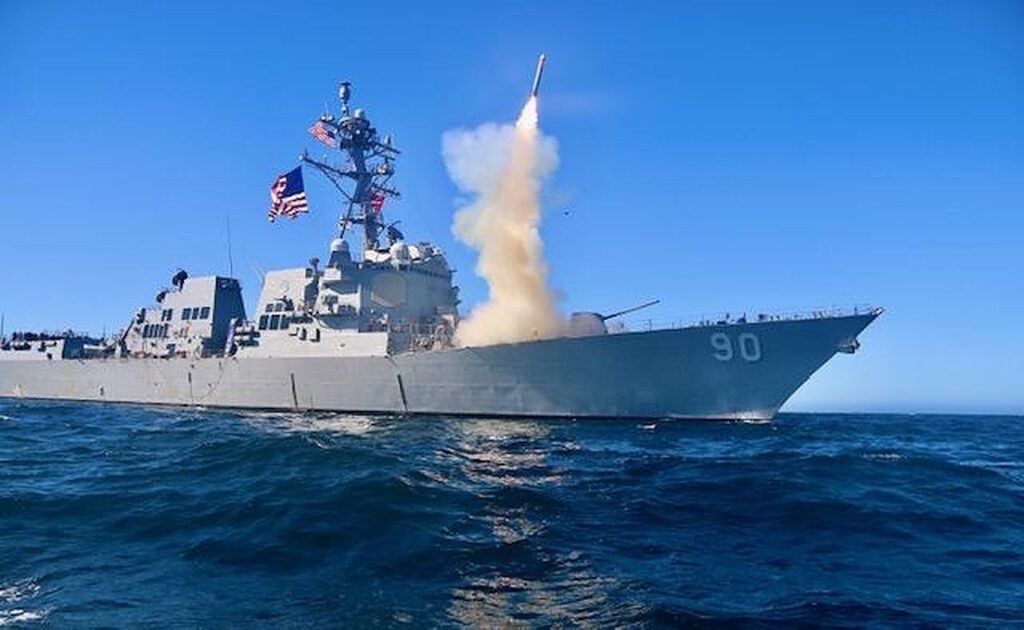
Kalibr vs Tomahawk
The Kalibr suite was designed to compare favourably with Washington’s prolific but ageing Tomahawk cruise missiles. Whereas the original Kalibr 3M14 traded performance blows with the Tomahawk’s Block IV revision in what amounts to an approximate draw tilted slightly in Kalibr’s favour, Kalibr-M drastically outranges its US counterpart at 4,500 against 1,700 kilometres. The most significant advantage of the 3M14T and its family is that they can be fired from a wider variety of smaller ships than the American ones that usually carry the Tomahawk, making it easier to deploy. It is also being developed to fire from fixed land bases, vehicles, and aircraft.
Kalibr may not have some of the advanced loitering and interactive data link capabilities of the current Tomahawk, but that might well make it cheaper to mass-produce (in addition to parts commonality with family variants).
Tomahawk likely outclasses Kalibr is ECM capability. While Tomahawk’s IV block revision included electronic counter-countermeasures, the Kalibr family is relatively susceptible to jamming techniques. With the modification, Block V Tomahawk has improved its capabilities. Its networking capabilities are beyond that of most operational cruise missiles by a long margin.
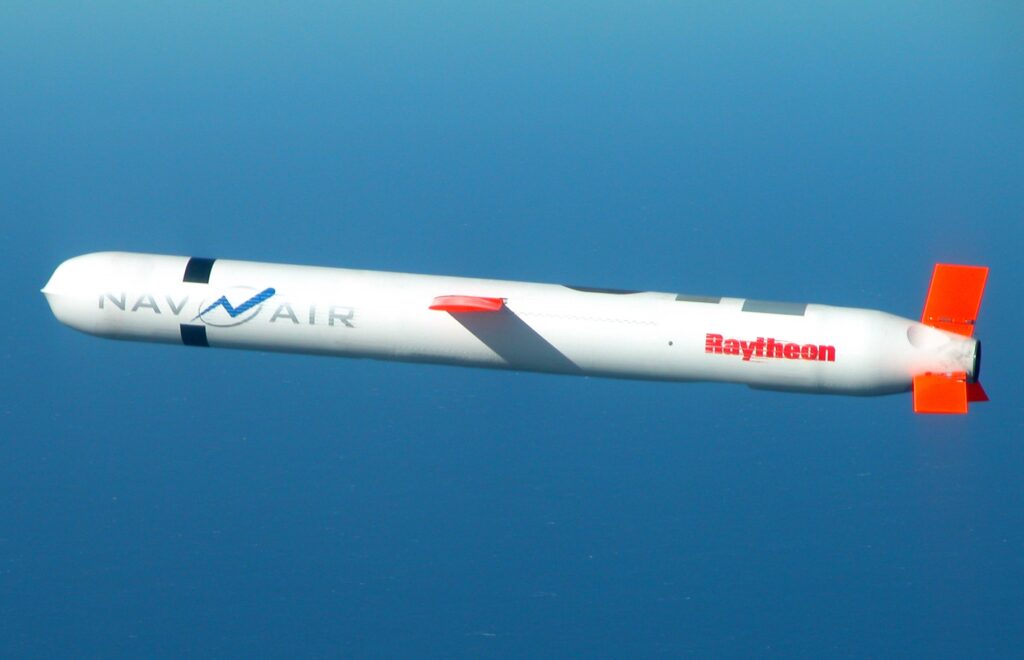
It is impossible to make a complete comparison between two missiles with limited knowledge about KALIBR cruise missiles at this stage. The Tomahawk has over 30 years of proven combat effectiveness, while the Kalibir only appeared in 2012. The Tomahawk has been regularly upgraded and improved and renown for its accuracy, but Russia does not make public the accuracy or reliability of the Kalibr missiles it has fired. Anyhow Russian Navy has gained a strategic capability with Kalibr cruise missiles.
Check out Naval Library App to find out the specifications of Tomahawk and Kalibr missiles.

"Naval Post" is an online defense media company, focused on Warships, Submarines, Naval Air and Naval Missiles.
- Advertise With Us
- Submit a News Tip
© Naval Post 2018-2023
Search form
- Publications
- Get Involved
- Planned Giving
Russian Offensive Campaign Assessment, February 7, 2024

Karolina Hird, Christina Harward, Nicole Wolkov, and Fredrick W. Kagan
February 7, 2024, 8:10pm ET
Click here to see ISW’s interactive map of the Russian invasion of Ukraine. This map is updated daily alongside the static maps present in this report.
Click here to see ISW’s 3D control of terrain topographic map of Ukraine. Use of a computer (not a mobile device) is strongly recommended for using this data-heavy tool.
Click here to access ISW’s archive of interactive time-lapse maps of the Russian invasion of Ukraine. These maps complement the static control-of-terrain map that ISW produces daily by showing a dynamic frontline. ISW will update this time-lapse map archive monthly.
Note: The data cut-off for this product was 1:30pm ET on February 7. ISW will cover subsequent reports in the February 8 Russian Offensive Campaign Assessment.
Russian forces conducted the second largest combined drone and missile strike of 2024 on the morning of February 7. Ukrainian military sources stated that Russian forces launched 64 drones and missiles at Ukraine: 20 Shahed 136/131 drones; 29 Kh-101/555/55 cruise missiles; four Kh-22 cruise missiles; three Kalibr cruise missiles; three Iskander-M ballistic missiles; and five S-300 surface-to-air missiles. [1] Ukrainian air defenses destroyed 44 of 64 targets: 26 Kh-101/555/55 cruise missiles; three Kalibr cruise missiles; and 15 Shahed-131/131 drones. [2] The Kyiv City Administration reported that Russian forces launched at least two dozen of the Kh-101/555/55 cruise missiles at Kyiv City and damaged residential infrastructure in several neighborhoods. [3] Ukrainian sources additionally stated that Russian forces hit Kharkiv City with S-300 surface-to-air missiles and Kh-22 cruise missiles and confirmed that two missiles that struck Kharkiv City were North Korean-provided Kn-23 (Hwasong-11 Ga) missiles. [4] Ukrainian outlet Suspilne reported that its sources in Ukrainian law enforcement suggested that Russian forces may have additionally launched 3M22 Zircon ship-launched hypersonic cruise missiles at Kyiv City but that they are still working to confirm this information. [5]
The February 7 strike package is emblematic of the constant air domain offense-defense innovation-adaptation race in which Russia and Ukraine are engaged . Ukrainian air defense managed to shoot down the majority of the Kh-101/555/55 cruise missiles and Shahed drones, which may suggest that Russian forces fired the Kh-101 series missiles and Shaheds in order to distract Ukrainian air defense. Ukrainian forces did not shoot down any of the Kh-22 cruise missiles, Iskander-M ballistic missiles, or S-300 surface-to-air missiles, by contrast. Russian forces may have specifically designed this strike package to distract Ukrainian air defense with the Kh-101s and Shahed combination with the intention of helping the other missiles make it through to their intended targets. The unconfirmed reports of 3M22 Zircon strikes are also noteworthy as Zircons are typically fired from naval vessels at other vessels or coastal targets, so Russian forces may have had to adapt the Zircon launchers to strike targets so far inland. [6] Russian forces additionally appear to have integrated North Korean missiles into their strike packages, which may have been harder for Ukrainian forces to detect and shoot down. ISW has previously assessed that Russia is experimenting with the strike packages it can launch at Ukraine to achieve the maximum desired effect, and that Ukraine in return continues efforts to adapt and respond to new Russian strike packages. [7]
Russia targeted Kyiv City during the February 7 strike for the third time thus far in 2024, notably coinciding with EU High Commissioner Josep Borrell’s visit to Kyiv. [8] Borrell arrived in Kyiv on February 6 to discuss EU military aid and continued support to Ukraine. [9] Russia has previously targeted Kyiv City during high-level foreign visits, such as UN Secretary-General Antonio Guterres’s visit in April 2022. [10] The US is also, of course, currently engaged in critical discussions over continued military aid to Ukraine, and Russia has frequently timed such massive missile strikes with international aid discussions to deter continued Western support for Ukraine. [11] Russia likely therefore purposefully conducted this strike series and targeted Kyiv City to achieve informational effects in the EU and the collective West apart from any objectives it was intended to achieve in Ukraine.
Deputy Chairperson of the Russian Security Council Dmitry Medvedev continued his nuclear saber-rattling rhetoric likely aimed in part at deterring Western aid to Ukraine. Medvedev claimed on February 7 that Russia has repeatedly “underscored” that it’s “plans” do not include any conflict “with NATO and EU member states.” [12] Kremlin officials, including Russian President Vladimir Putin, however, have recently and consistently rhetorically threatened NATO member states, and Kremlin-affiliated actors appear to be attempting to sow instability and set information conditions for possible future Russian aggressive actions against various European states. [13] Medvedev stated that NATO’s military budget and population are significantly larger than Russia’s, so that if a war were to break out between Russia and NATO, Russia would have to respond “asymmetrically” by using “ballistic and cruise missiles carrying special warheads” — referring to nuclear warheads — resulting in an “apocalypse.” Medvedev posted these claims on his English language X (formerly Twitter) channel and Russian language Telegram channel, suggesting that his statements are meant for both an international and domestic audience. Kremlin officials and pundits have consistently threatened to use nuclear weapons against NATO members, and ISW continues to assess that this nuclear rhetoric is aimed at deterring Western aid to Ukraine. [14] Medvedev‘s statements about NATO’s larger size and military budget relative to Russia are likely aimed at domestically promoting Kremlin narratives that NATO — and the West generally — poses an existential threat to Russia — a claim the Kremlin has used to try to justify its full-scale invasion of Ukraine. [15]
The Russian Federation Council approved a bill on February 7 that allows the Russian government to confiscate property from individuals convicted of spreading “fake” information about the Russian military, likely as part of ongoing censorship efforts to limit criticisms of Russia’s war effort ahead of the March 2024 Russian presidential election. [16] The bill also allows Russian authorities to confiscate property from individuals found guilty of calling for terrorist or extremist activities and advocating for sanctions against Russia. [17] ISW previously observed increasing complaints from the relatives of mobilized Russian servicemen concerning the Russian military’s mistreatment of mobilized personnel, and continues to assess that the Kremlin likely wants to silence concerned relatives to maintain appearances of wide support for the war ahead of the presidential election. [18]
Yandex NV — the Dutch holding company of Russian internet technology company Yandex — announced that it will sell all of its Russian assets for 475 billion rubles (about $5.2 billion) to a purchasing consortium consisting of five Russian companies. Yandex stated in a press release published on February 5 that the purchasing consortium will pay at least half of the considerations in cash using Chinese yuan. [19] Yandex NV will maintain no businesses in Russia but will continue to hold four international businesses. The New York Times ( NYT ) reported that Yandex NV made 95 percent of its revenues between January and September 2023 in Russia. [20] ISW continues to assess that the Kremlin is likely nationalizing Yandex in order to strengthen control over the Russian information space, especially in preparation for the March 2024 Russian presidential election. [21]
Key Takeaways:
- Russian forces conducted the second largest combined drone and missile strike of 2024 on the morning of February 7. The February 7 strike package is emblematic of the constant air domain offense-defense innovation-adaptation race in which Russia and Ukraine are engaged .
- Russia targeted Kyiv City during the February 7 strike for the third time thus far in 2024, notably coinciding with EU High Commissioner Josep Borrell’s visit to Kyiv.
- Deputy Chairperson of the Russian Security Council Dmitry Medvedev continued his nuclear saber-rattling rhetoric likely aimed in part at deterring Western aid to Ukraine.
- The Russian Federation Council approved a bill on February 7 that allows the Russian government to confiscate property from individuals convicted of spreading “fake” information about the Russian military, likely as part of ongoing censorship efforts to limit criticisms of Russia’s war effort ahead of the March 2024 Russian presidential election.
- Yandex NV — the Dutch holding company of Russian internet technology company Yandex — announced that it will sell all of its Russian assets for 475 billion rubles (about $5.2 billion) to a purchasing consortium consisting of five Russian companies.
- Russian forces made confirmed gains west of Horlivka and in the Donetsk-Zaporizhia Oblast border area amid continued positional engagements along the entire frontline.
- The Ukrainian Main Military Intelligence Directorate (GUR) stated on February 7 that Russia is mobilizing citizens from Syria who come to Russia under the guise of security guard jobs at oil refineries.
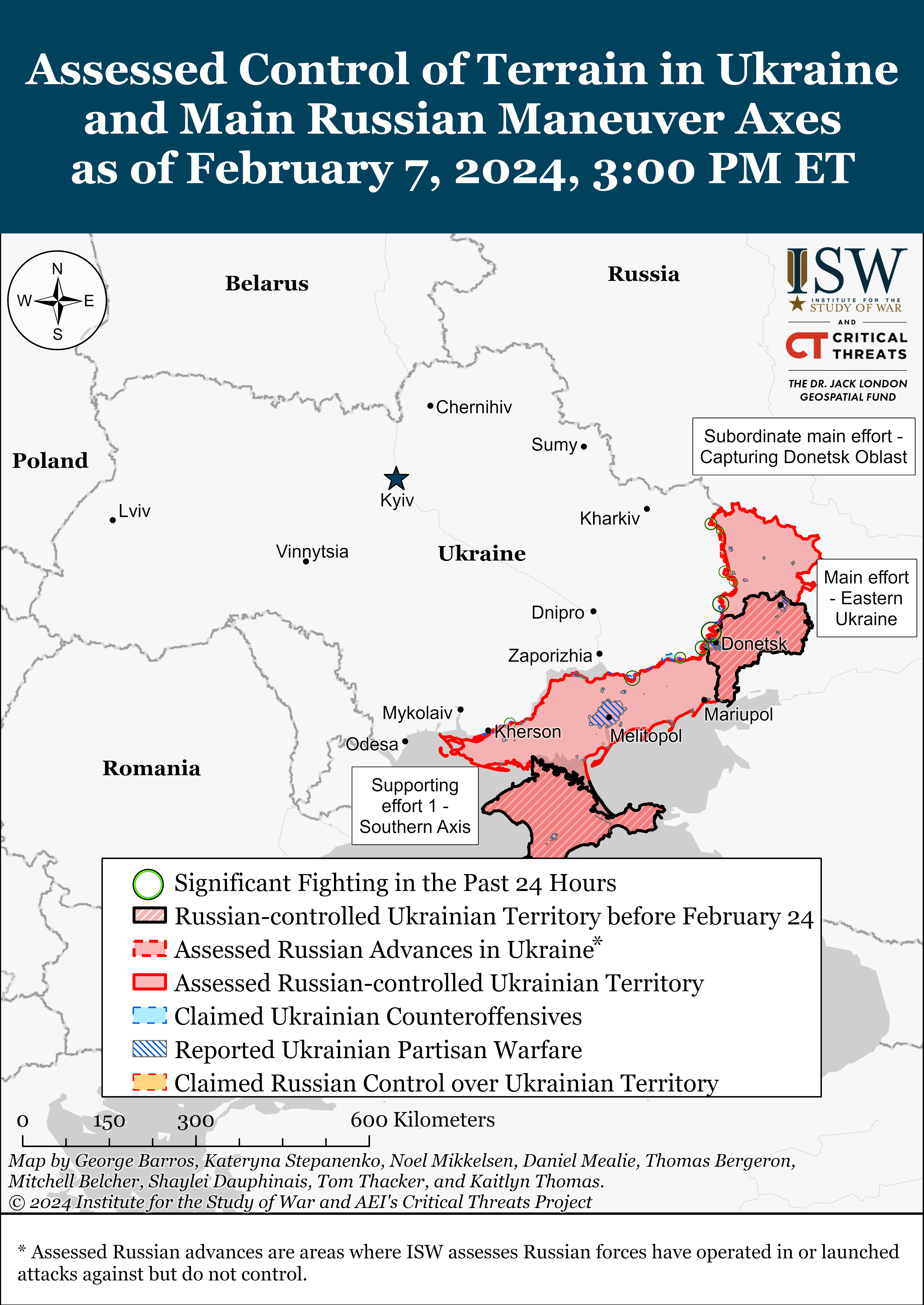
We do not report in detail on Russian war crimes because these activities are well-covered in Western media and do not directly affect the military operations we are assessing and forecasting. We will continue to evaluate and report on the effects of these criminal activities on the Ukrainian military and the Ukrainian population and specifically on combat in Ukrainian urban areas. We utterly condemn Russian violations of the laws of armed conflict and the Geneva Conventions and crimes against humanity even though we do not describe them in these reports.
- Russian Main Effort – Eastern Ukraine (comprised of two subordinate main efforts)
- Russian Subordinate Main Effort #1 – Capture the remainder of Luhansk Oblast and push westward into eastern Kharkiv Oblast and encircle northern Donetsk Oblast
- Russian Subordinate Main Effort #2 – Capture the entirety of Donetsk Oblast
- Russian Supporting Effort – Southern Axis
- Russian Air, Missile, and Drone Campaign
- Russian Mobilization and Force Generation Efforts
- Russian Technological Adaptations
- Ukrainian Defense Industrial Base Efforts
- Activities in Russian-Occupied Areas
Russian Information Operations and Narratives
- Significant Activity in Belarus
Russian Main Effort – Eastern Ukraine
Russian Subordinate Main Effort #1 – Luhansk Oblast (Russian objective: Capture the remainder of Luhansk Oblast and push westward into eastern Kharkiv Oblast and northern Donetsk Oblast)
Select Rosgvardia elements have reportedly conducted an operational redeployment to Belgorod Oblast border areas. Ukrainian military observer Kostyantyn Mashovets stated on February 7 that elements of Rosgvardia’s 116th Special Purpose Brigade, namely its 900th and 902nd Regiments, redeployed to Belgorod Oblast from occupied Donetsk Oblast in the first week of February. [22] Mashovets noted that these regiments have a particularly powerful artillery complement, which is likely why they have been redeployed to the Belgorod Grouping of Forces. ISW previously observed that Rosgvardia’s 116th Special Purpose Brigade and its new constituent regiments deployed to occupied Donetsk Oblast in late December 2023 to serve law enforcement purposes in occupied Ukraine, so their rapid redeployment away from occupied Ukraine is noteworthy. [23] ISW also previously assessed that Russian forces may launch tactical diversionary cross-border raids into Kharkiv Oblast from Belgorod Oblast to distract and pin Ukrainian forces away from the Kupyansk-Svatove-Kreminna axis, where Russian forces are currently pursuing offensive operations, and the deployment of at least two Rosgvardia regiments may be in support of such future diversionary activities. [24] Russian forces remain unlikely to be able to conduct large-scale offensive operations into Kharkiv Oblast from Belgorod Oblast, however. [25]
Positional engagements continued along the Kupyansk-Svatove-Kreminna line on February 7, but there were no confirmed changes to the frontline in this area. Russian and Ukrainian forces reported positional fighting northeast of Kupyansk near Synkivka and Ivanivka; southeast of Kupyansk near Tabaivka; west of Kreminna near Terny and Torske; southwest of Kreminna near Hryhorivka; and south of Kreminna near Bilohorivka. [26] Russian sources claimed that Russian forces reached tactical heights east of Terny and captured a position in the Bilohorivka industrial zone, but ISW has not observed visual evidence of these claimed gains. [27] A Russian milblogger reported that Russian forces intend to reach the Oskil River in the Kupyansk direction and capture the city of Lyman west of Kreminna. [28] Elements of the Russian 7th Motorized Rifle Brigade (2nd Luhansk People’s Republic [LNR] Army Corps) are reportedly operating near Bilohorivka. [29]
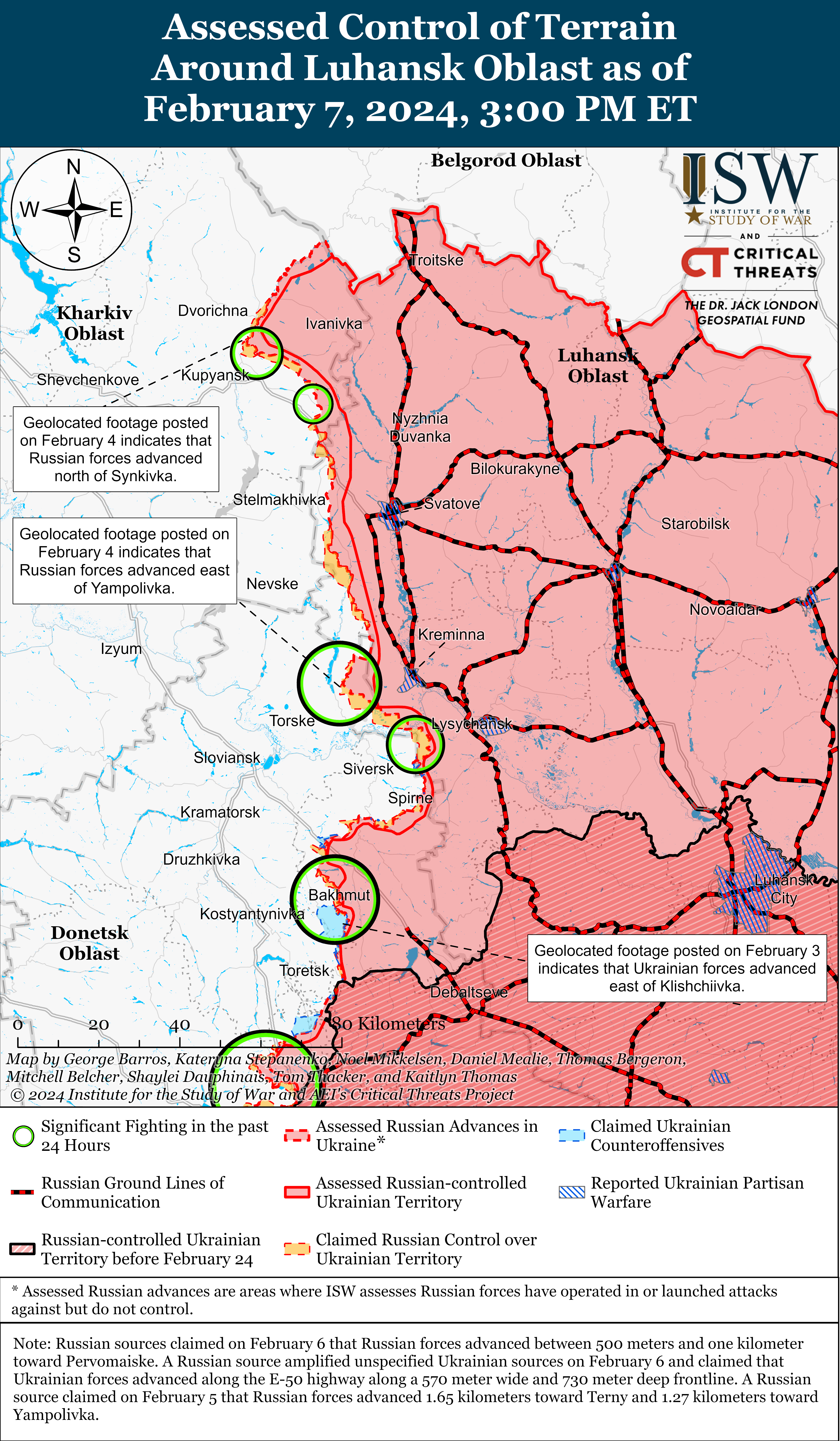
Russian Subordinate Main Effort #2 – Donetsk Oblast (Russian objective: Capture the entirety of Donetsk Oblast, the claimed territory of Russia’s proxies in Donbas)
Limited positional engagements continued near Bakhmut on February 7, but there were no confirmed changes to the frontline. Ukrainian and Russian sources reported positional fighting northwest of Bakhmut near Bohdanivka; west of Bakhmut near Ivanivske; and southwest of Bakhmut near Klishchiivka. [30] Elements of the Russian 11th Separate Guards Air Assault (VDV) Brigade are reportedly operating west of Bakhmut, and elements of the 51st Guards VDV Regiment (106th VDV Division) are reportedly operating northeast of Bakhmut near Soledar. [31]
Geolocated footage posted on February 7 shows that Russian forces recently made a marginal advance northeast of Niu-York (west of Horlivka). [32] The Russian Ministry of Defense (MoD) claimed that Russian forces repelled Ukrainian attacks northwest of Horlivka near Shumy and Pivdenne. [33] Drone operators of the “Russkiye Yastreby” (Russian Hawks) detachment (33rd Motorized Rifle Regiment, 1st Donetsk People’s Republic [DNR] Army Corps] are reportedly operating near Horlivka. [34]
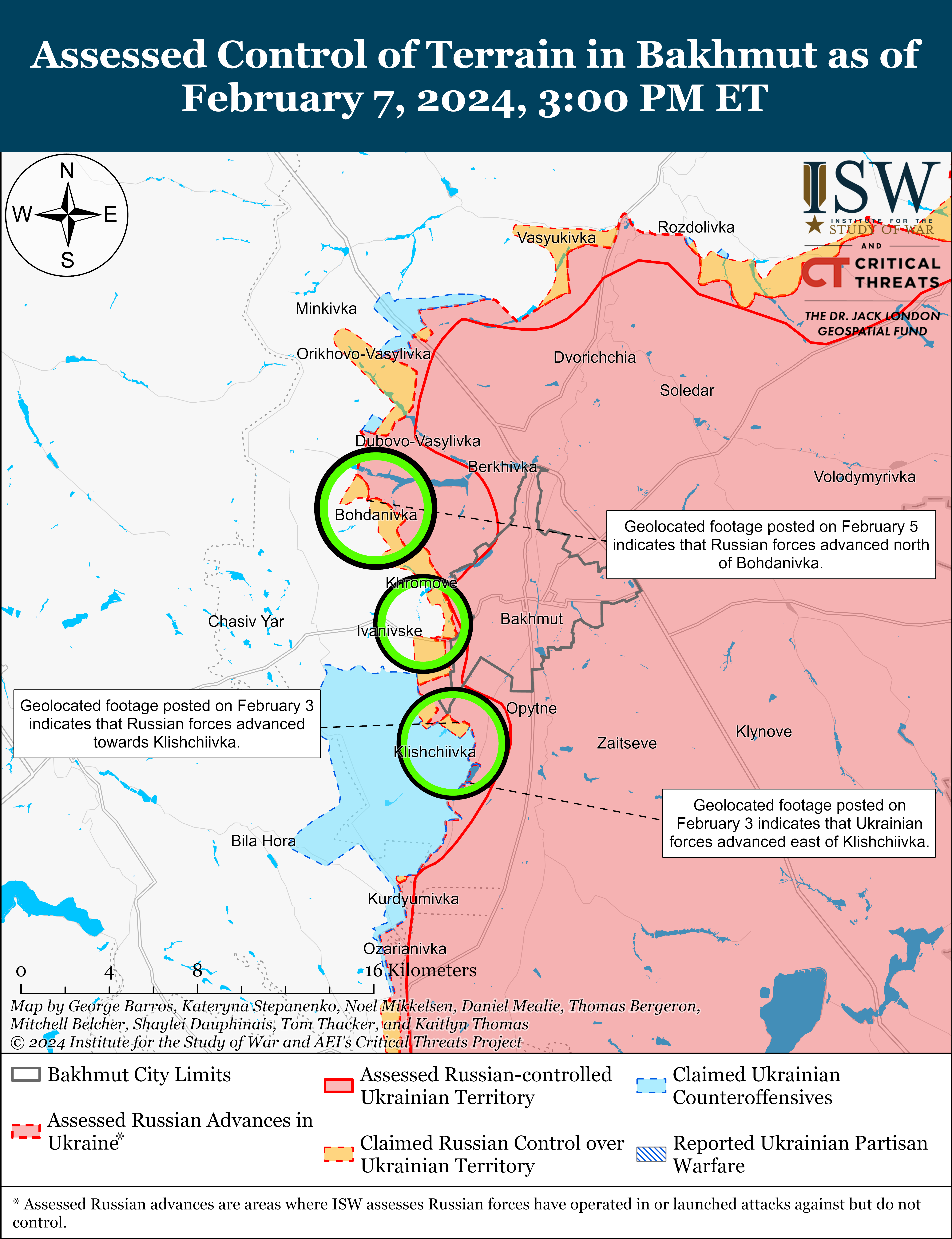
Russian forces reportedly continued advancing in northern Avdiivka, although there were no confirmed control of terrain changes in this area on February 7. Several Russian milbloggers claimed that Russian forces advanced southward along Zaliznychnyi Lane in northwestern Avdiivka. [35] One Russian milblogger claimed that elements of the 114th Motorized Rifle Brigade (1st DNR Army Corps) and the 30th Motorized Rifle Brigade (2nd Combined Arms Army [CAA], Central Military District [CMD]) penetrated the Ukrainian grouping on Zaliznychnyi Lane in a maneuver intended to cut off and isolate Ukrainian forces into two groupings at the point of penetration. [36] Ukrainian military observer Kostyantyn Mashovets stated that Russian forces have reached the northern part of a gardening partnership on Zaliznychnyi Lane. [37] Russian milbloggers also claimed that Russian forces advanced westward towards the Coke Plant in northwestern Avdiivka. [38] Mashovets stated that Russian forces are now focusing on interdicting Hrushevskoho Street, the remaining Ukrainian ground line of communication (GLOC) that runs west of the Coke Plant and into Avdiivka via the northwestern part of the settlement. [39] Russian milbloggers claimed that Russian forces now control between 18 and 20 percent of Avdiivka. [40] Elements of the Russian 239th and 80th Tank Regiments (both of 90th Tank Division, 41st CAA, CMD); the 21st, 30th, and 15th Motorized Rifle Brigades (all of the 2nd CAA, CMD); and 9th and 114th Motorized Rifle Brigade (both of 1st DNR Army Corps) are reportedly operating in the Avdiivka direction. [41]
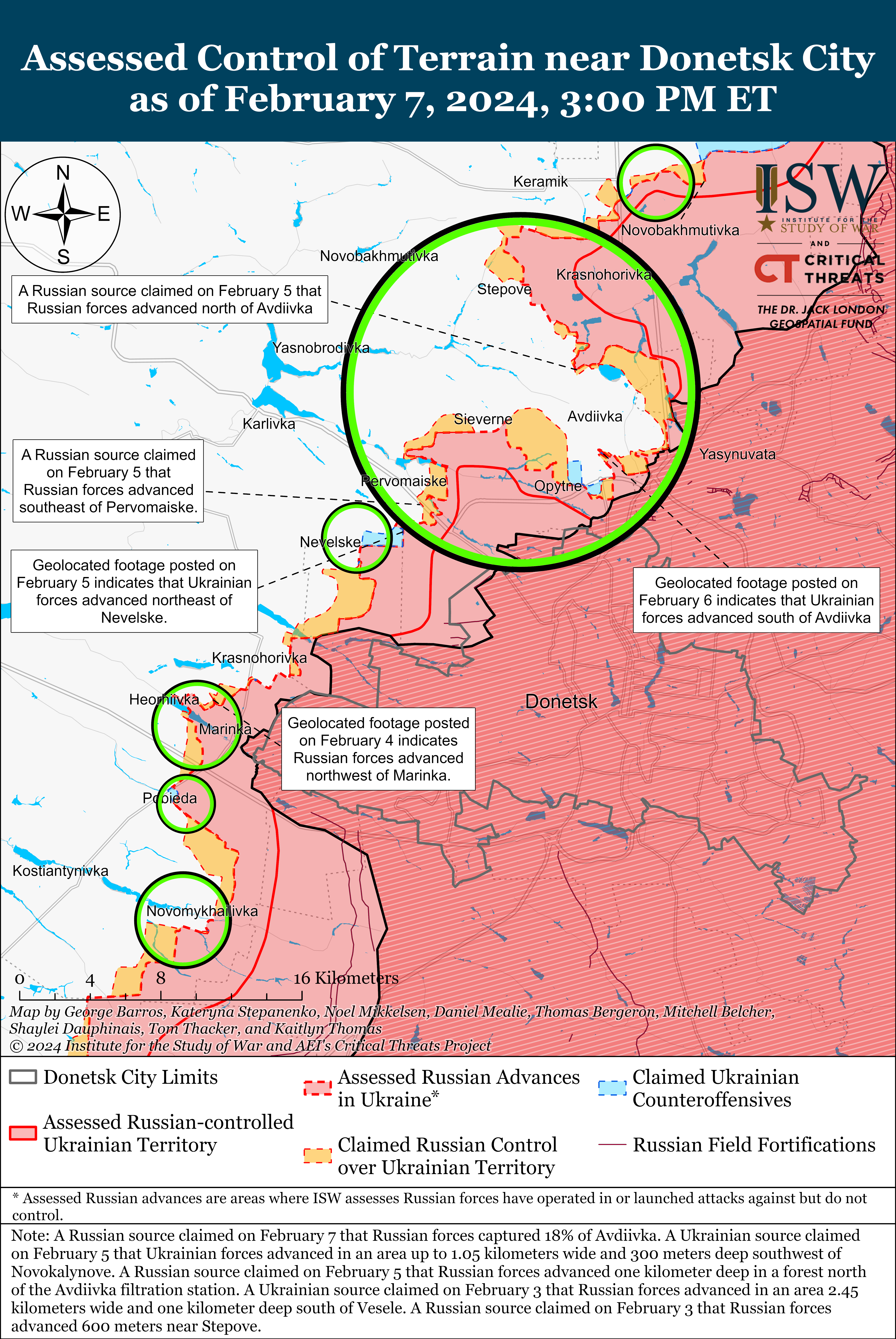
Russian forces recently made confirmed advances west and southwest of Donetsk City. Geolocated footage posted on February 7 shows that Russian forces advanced into the eastern outskirts of Heorhiivka (just west of Donetsk City), and several milbloggers claimed that Russian forces have gained a foothold in the settlement. [42] Additional geolocated footage posted on February 7 indicates that elements of the Russian 155th Naval Infantry Brigade (Pacific Fleet) advanced into eastern Novomykhailivka along Lenin Street, which accords with several Russian milblogger claims that Russian forces entered eastern Novomykhailivka. [43] Ukrainian and Russian sources reported that positional engagements continued west of Donetsk City near Krasnohorivka and Heorhiivka and southwest of Donetsk City near Pobieda and Novomykhailivka. [44]
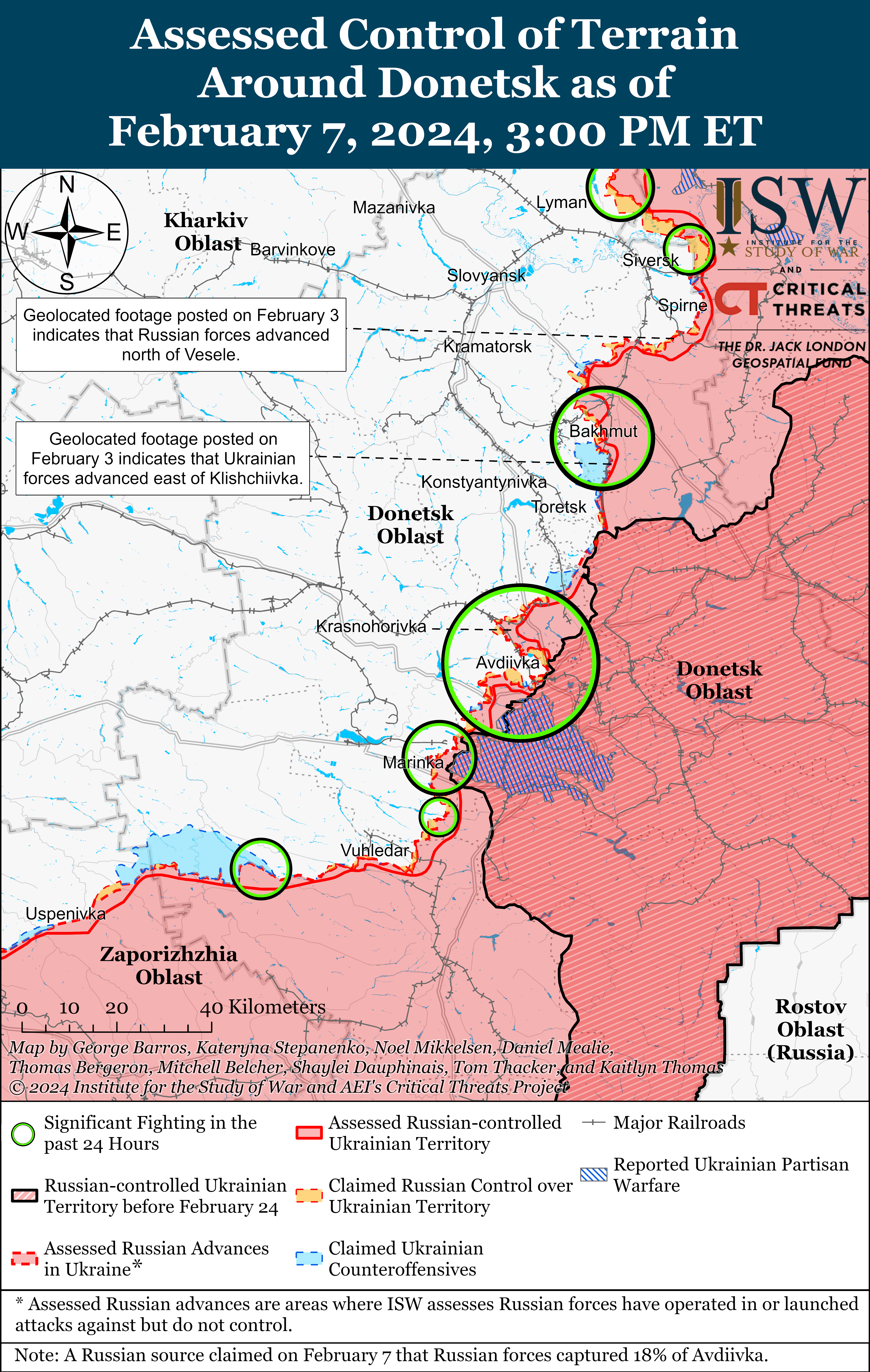
Russian Supporting Effort – Southern Axis (Russian objective: Maintain frontline positions and secure rear areas against Ukrainian strikes)
Russian forces recently made confirmed advances in the Donetsk-Zaporizhia Oblast border area amid continued positional engagements in the area on February 7. Geolocated footage published on February 6 and NASA Fire Information for Resource Management (FIRMS) data from February 6 indicate that Russian forces advanced north of Mykilske (east of Vuhledar). [45] A Russian milblogger claimed that Russian forces advanced east of Vuhledar towards the Pivdennodonbaska Coal Mine. [46] Another Russian milblogger claimed that Russian forces advanced south of Velyka Novosilka near Staromayorske, but ISW has not observed visual confirmation of this claim. [47] Ukrainian and Russian sources stated that positional engagements continued southeast of Velyka Novosilka near Zolota Nyva and southwest of Velyka Novosilka near Pryyutne. [48] Elements of the Russian 11th Air and Air Defense Forces Army (Eastern Military District [EMD]) are reportedly operating near Urozhaine (south of Velyka Novosilka); elements of the 218th Tank Regiment (127th Motorized Rifle Division, 5th Combined Arms Army [CAA], EMD) are reportedly operating north of Pryyutne; and elements of the 114th Motorized Rifle Regiment (127th Motorized Rifle Division, 5th CAA, EMD) are reportedly conducting strikes near Chervone (southwest of Velyka Novosilka). [49]
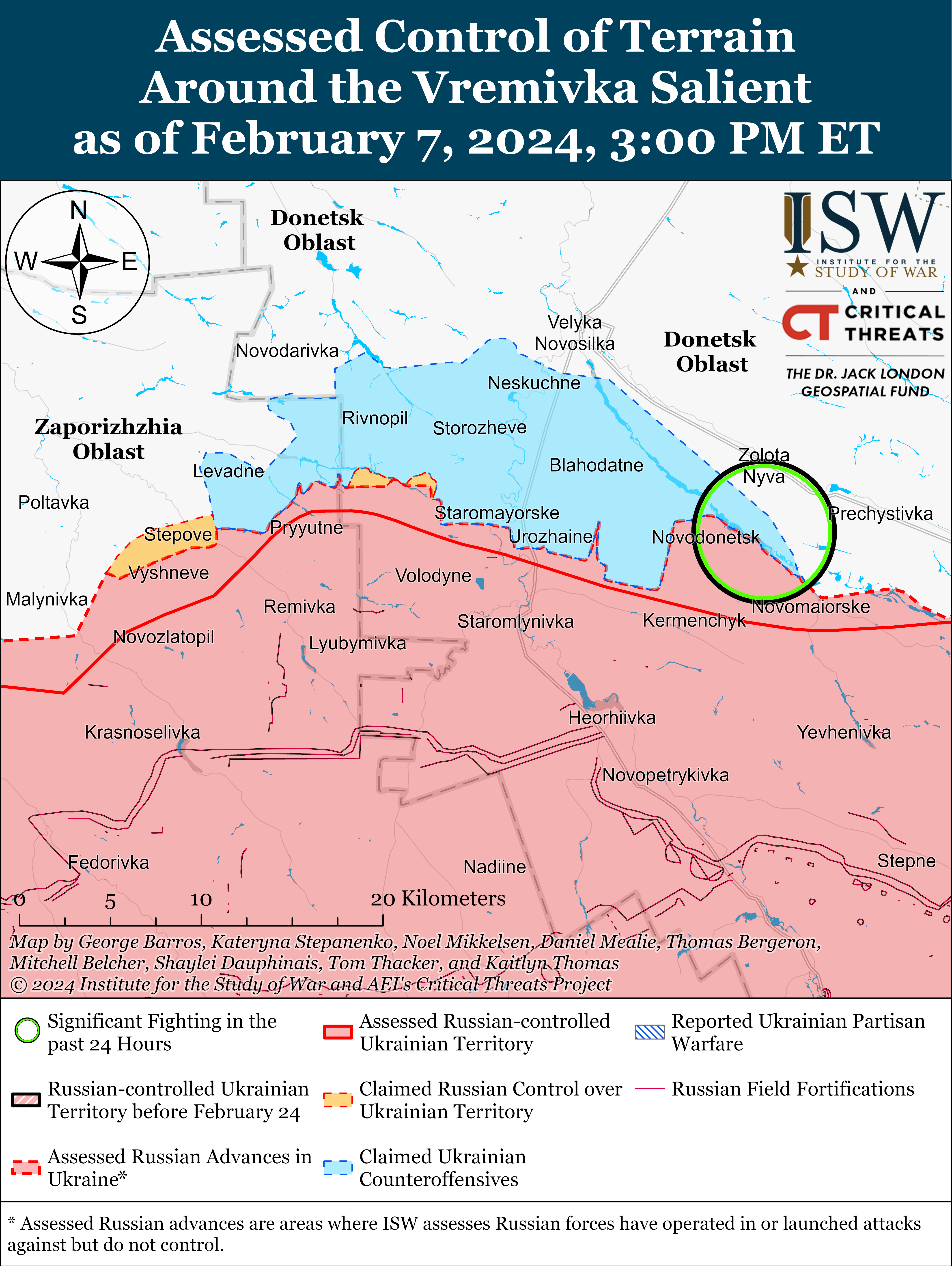
Positional engagements continued in western Zaporizhia Oblast on February 7, but there were no confirmed changes to the frontline in this area. Ukrainian and Russian sources stated that positional engagements continued near Robotyne and Verbove (east of Robotyne). [50] A Russian milblogger claimed that Ukrainian drones are limiting Russian forces’ ability to use armored vehicles during the day and night in the Orikhiv direction and that Russian forces are suffering from an acute shortage of drones. [51] The milblogger claimed that Russian forces are currently concentrating on the Bakhmut and Donetsk directions but suggested that Russian forces resume offensive operations in the Zaporizhia direction to stretch Ukrainian reserves and pull them away from other critical axes. Elements of the Russian 136th Motorized Rifle Brigade (58th CAA, Southern Military District [SMD]) are reportedly operating in the Zaporizhia direction; elements of the Russian 291st Motorized Rifle Regiment (42nd Motorized Rifle Division, 58th CAA, SMD) are reportedly operating near Robotyne; elements of the BARS-10 (Russian Combat Army Reserve) are reportedly operating near Kamianske (northwest of Robotyne); and elements of the 503rd Motorized Rifle Regiment (19th Motorized Rifle Division, 58th CAA, SMD) are reportedly operating near Novoandriivka (northwest of Robotyne). [52]
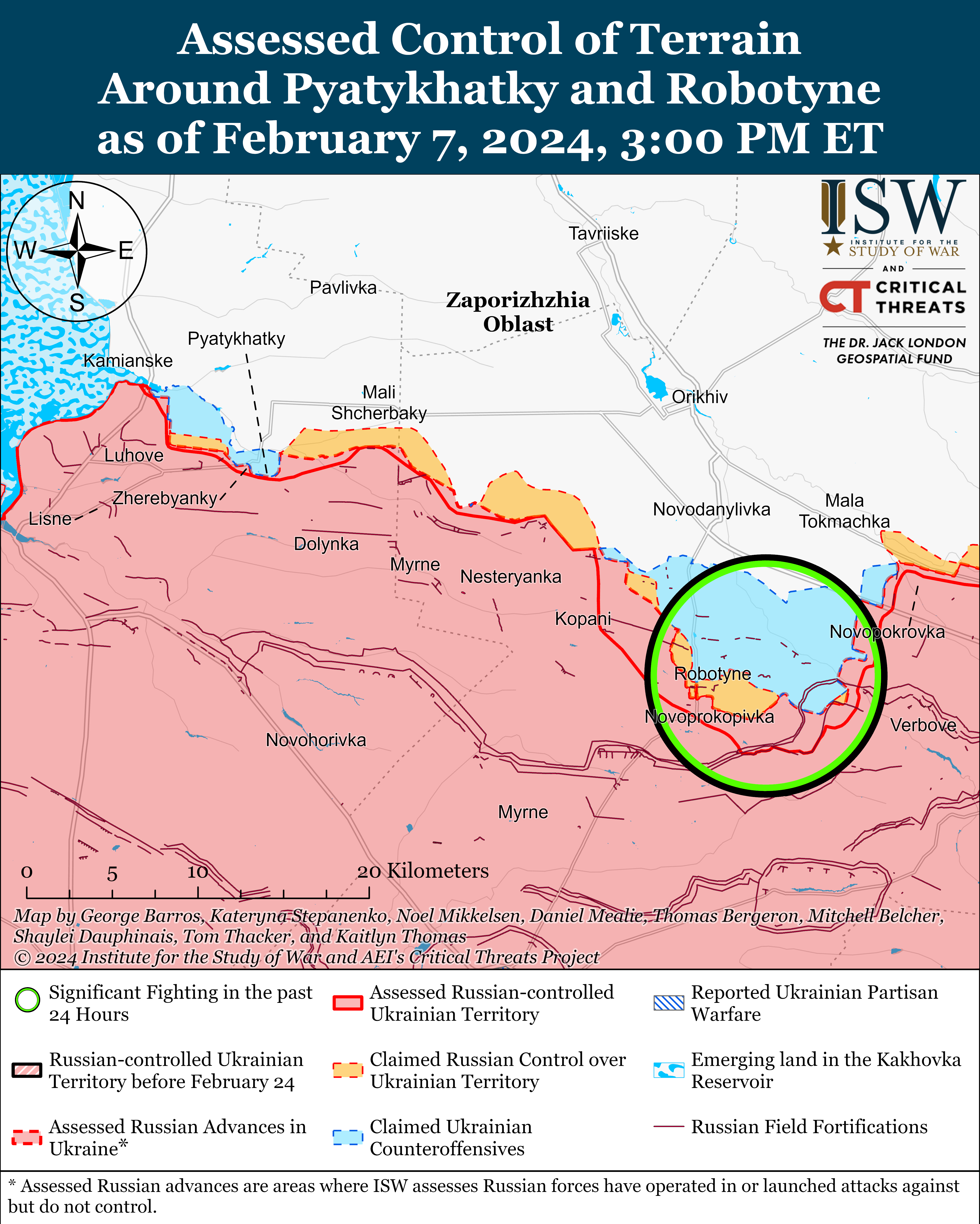
International Atomic Energy Agency (IAEA) Director Rafael Grossi visited the Zaporizhzhia Nuclear Power Plant (ZNPP) on February 7. Grossi met with Ukrainian Energy Minister Herman Halushchenko on February 6 and stated that the number of personnel at the ZNPP is about 2,000 to 3,000, whereas the previous staffing levels had been 12,000 personnel. [53] Grossi stated that the situation at the ZNPP is “so far...stable” but in a “very delicate equilibrium.” The Russian Ministry of Defense (MoD) posted footage on February 7 of Russian military personnel escorting Grossi and the IAEA delegation to the ZNPP. [54] The Russian MoD claimed that the delegation visited various parts of the ZNPP’s fourth power unit and that experts have been present at the ZNPP since September 2022.
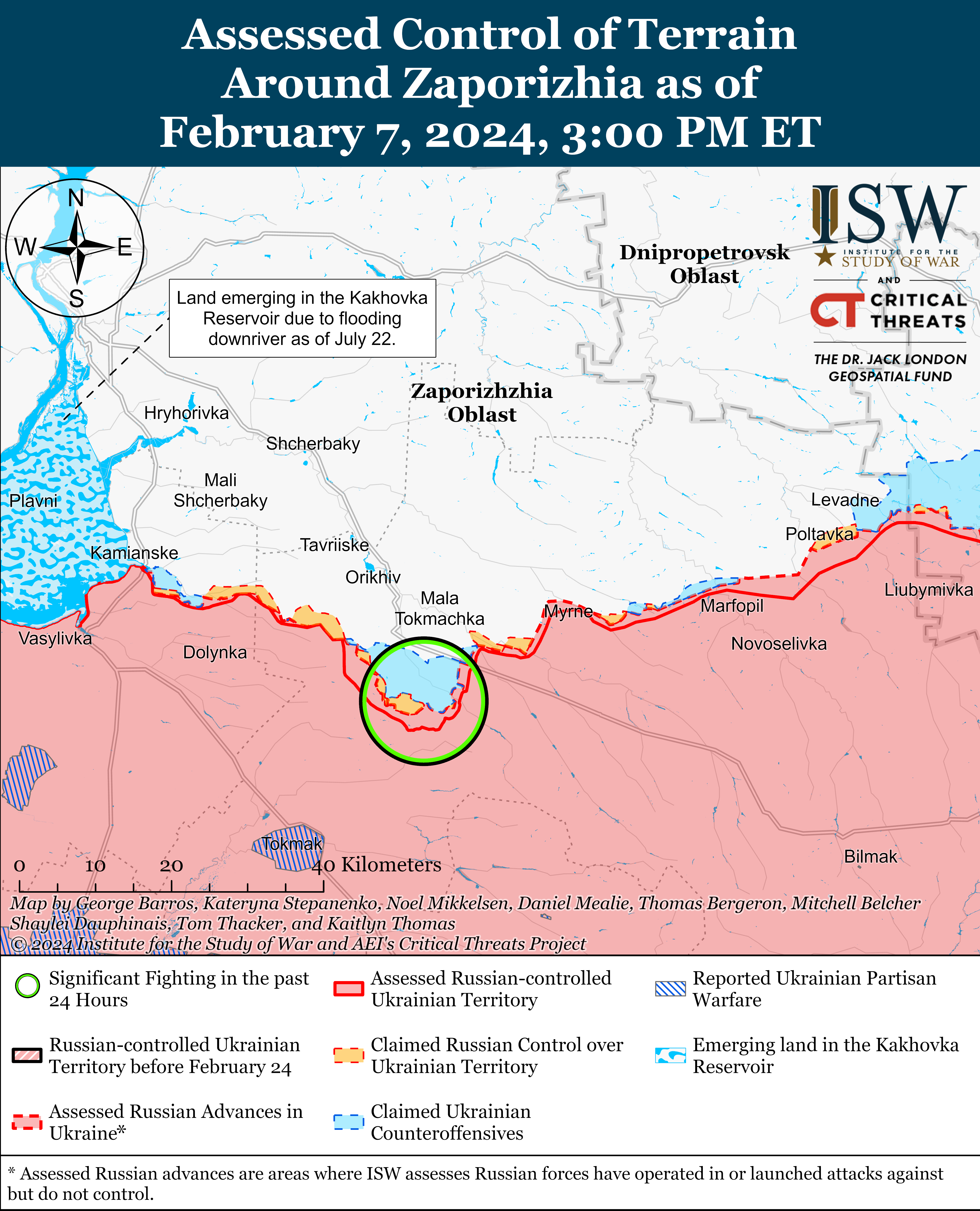
Ukrainian and Russian forces made confirmed advances in east (left) bank Kherson Oblast amid continued positional engagements in the area on February 7. Geolocated footage published on February 7 indicates that Ukrainian forces advanced in eastern Krynky. [55] Additional geolocated footage published on February 7 indicates that Russian forces advanced in southern Krynky. [56] Ukrainian and Russian sources stated that positional engagements continued in Krynky. [57]
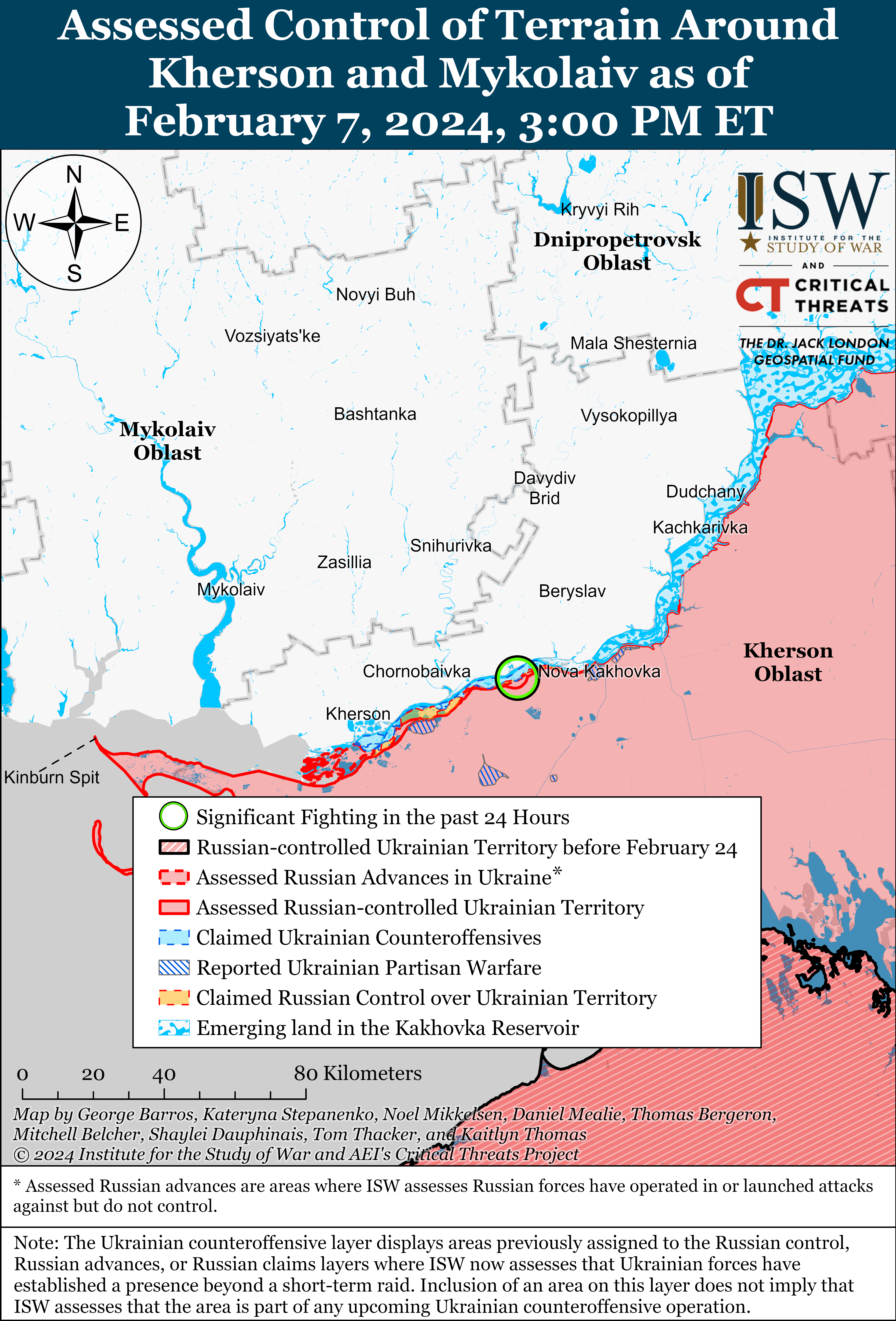
Russian Air, Missile, and Drone Campaign (Russian Objective: Target Ukrainian military and civilian infrastructure in the rear and on the frontline)
See topline text.
Russian Mobilization and Force Generation Efforts (Russian objective: Expand combat power without conducting general mobilization)
The Ukrainian Main Military Intelligence Directorate (GUR) stated on February 7 that Russia is mobilizing citizens from Syria who come to Russia under the false promise of employment as security guards at oil refineries. [58] The GUR reported that Russia is using “tourist companies” to recruit civilians in Syria for jobs in the Sakha Republic. The GUR stated that about 1,000 Syrian mercenaries are currently undergoing training, especially in urban combat, in Syria before they go to the Sakha Republic. The GUR found that Russian authorities then “lure” the Syrians to “higher paying jobs” in Buryatia Republic, where Russian authorities issue them Russian passports and mobilize them into the military. The GUR noted that a group of Syrian mercenaries who received Russian passports are currently in Ulan-Ude and will join the Russian 5th Tank Brigade (36th Combined Arms Army, Eastern Military District).
Western sanctions are reportedly pushing Chinese banks to stop or restrict Russian transactions. Russian outlet Vedomosti stated on February 6 that the Chinese Zhejiang Chouzhou Commercial Bank, which is reportedly the main bank for Russian importers working with China, notified its clients that is suspending all transactions with Russian and Belarusian organizations. [59] Vedomosti reported that its sources stated that the bank initially stopped payments for certain goods that fall under Western sanctions in December 2023 but later completely stopped any transactions with Russia regardless of the product, the currency of payment, or the payment system used, out of fear of Western banks requesting reports on these transactions. Vedomosti stated that other unspecified Chinese banks are also restricting Russian transactions and are requiring confirmation that the buyer does not have contact with sanctioned people or companies, that the products will not be used in the Russian defense industrial base (DIB), and that the products will not go to occupied Crimea. At least two People’s Republic of China (PRC)-owned banks reportedly ordered reviews of international transactions with Russian clients in January after the US authorized secondary sanctions on financial institutions that facilitate Russian sanctions evasion and support the Russian war in Ukraine. [60] Turkish banks also reportedly started to close Russian companies’ accounts due to the threat of US secondary sanctions in early February. [61]
Russian state oil company Rosneft Head Igor Sechin is reportedly forming his own “Spetsnaz” (special purpose) force. A Russian insider source claimed that Sechin is forming a “Spetsnaz” force at his golf club in Krylyatskoye Raion, Moscow City. [62] The insider source claimed that Sechin intends to use his “Spetsnaz” force to guard Rosneft’s assets on “several continents,” including Africa. The insider source reported that Sechin’s “Spetsnaz” force is currently staffed by former Rosgvardia personnel and private security officers and that former Wagner Group and other veterans of the war in Ukraine are uninterested in joining due to low salaries. The source claimed that Sechin’s “Spetsnaz” force currently consists of two groups of up to 10 personnel each, but that Sechin will likely expand the group because the group formed at the end of 2023 and only began to receive funding in 2024. ISW cannot independently confirm any of the insider source’s claims. ISW previously observed that other Russian state-owned enterprises started their own similar “private military companies” (PMC) for security purposes, as was the case with Gazprom’s “Potok” battalion. [63]
Russian Technological Adaptations (Russian objective: Introduce technological innovations to optimize systems for use in Ukraine)
Russian state-owned defense corporation Rostec is testing the newly-developed “Prometheus” software and hardware complex that can turn an infantry fighting vehicle, armored personnel carrier, or tank into a remotely controlled robotic vehicle. [64] Kremlin newswire TASS reported on February 6 that a vehicle equipped with the Prometheus software and hardware complex can also move to a predetermined location without operator involvement while automatically determining the best route and avoiding obstacles.
Ukrainian Defense Industrial Efforts (Ukrainian objective: Develop its defense industrial base to become more self-sufficient in cooperation with US, European, and international partners)
Senior Ukrainian officials commented on Ukrainian President Volodymyr Zelensky’s announcement that Ukraine is forming a separate branch of unmanned systems forces within the Ukrainian military. Ukrainian Minister of Digital Transformation Mykhailo Fedorov stated on February 7 that the branch will have a new command structure that will help solve problems relating to radio frequency planning, interaction with electronic warfare (EW) systems, and launching remote EW systems. [65] Fedorov also stated that the Ukrainian military has three attack drone companies that are ready for deployment and that the Ukrainian Army of Drones project currently consists of 67 different drone models. [66]
Fedorov also stated on February 7 that Ukrainian companies have developed an analog for the Russian Lancet loitering munition. [67] Fedorov stated that Ukrainian companies have already tested the drones in combat conditions and that these drones may appear on the frontline in about two months.
Ecuador will reportedly exchange Soviet-era military equipment for $200 million worth of US-made equipment, allowing the US to then provide the Soviet equipment to Ukraine. [68] Ecuador is reportedly transferring six Osa-AKM anti-aircraft missile systems, 18 BM-21 Grad Multiple Rocket Launch Systems (MLRS), five Mi-17 helicopters, 128 ZPU-1-2 anti-aircraft machine guns, and 34 ZU-23-2 anti-aircraft machine guns to the US, which the US will send directly to Ukraine for use on the battlefield. [69]
Activities in Russian-occupied areas (Russian objective: Consolidate administrative control of annexed areas; forcibly integrate Ukrainian citizens into Russian sociocultural, economic, military, and governance systems)
Russian occupation authorities continue to militarize Ukrainian children and youth in occupied Ukraine. The Russian Investigative Committee gave a lecture to schoolchildren in occupied Donetsk Oblast on “countering extremism and terrorism” in order to develop “moral standards and patriotism” in the children. [70] Russian opposition media investigations have previously found that the Russian Investigative Committee and its head, Alexander Bastrykin, are directly involved in facilitating the deportation of children from occupied Ukraine to Russia, and that Bastrykin himself has overseen the placement of deported Ukrainian children into Russian cadet courses. [71] Ukrainian government, military, and partisan sources additionally reported on February 7 that Russian occupation authorities continue to introduce Russian military-patriotic education and military indoctrination to schools in occupied Ukraine through the ”Lessons in Courage” education program and other similar courses. [72]
Russian officials continue to claim that the West is at fault for the deteriorating relationship between the West and Russia. [73] Russian government officials are likely trying to frame continued Western support for Ukraine as the impetus for the deteriorating Russian-Western relationship to discourage the continued provision of Western military aid to Ukraine, despite the fact that Russia initiated military conflict with Ukraine in 2014 and then again in 2022 and has routinely threatened the EU and NATO. [74]
Russian Ambassador to North Korea Alexander Matseroga stated that Russian-North Korean relations are currently “unprecedented” and that the two states have developed “very close mutually beneficial cooperation” over the past several years, contrasting developing Russo-North Korean relations with Russia’s relationship with the EU and NATO. [75]
Significant Activity in Belarus (Russian efforts to increase its military presence in Belarus and further integrate Belarus into Russian-favorable frameworks and Wagner Group activity in Belarus)
The Ukrainian Resistance Center reported on February 7 that the Belarusian Committee of State Security (KGB) has increasingly questioned and searched Ukrainian citizens in Belarus in the past month. [76] The Ukrainian Resistance Center stated that Belarusian special services are looking to recruit Ukrainian citizens to use as informants.
Note: ISW does not receive any classified material from any source, uses only publicly available information, and draws extensively on Russian, Ukrainian, and Western reporting and social media as well as commercially available satellite imagery and other geospatial data as the basis for these reports. References to all sources used are provided in the endnotes of each update.
[1] https://www.facebook.com/CinCAFU/posts/pfbid02QE7Q3bM4v2tTGM3HCKP2DbWeLK... https://www.facebook.com/GeneralStaff.ua/posts/pfbid0L8f9GZw1XJgTP5LeHkg... ; https://www.facebook.com/GeneralStaff.ua/posts/pfbid0t1av9jbSpaEqyuKbrzi... ; https://t.me/astrapress/47535
[2] h ttps:// www.facebook.com/CinCAFU/posts/pfbid02QE7Q3bM4v2tTGM3HCKP2DbWeLKYzVXUCip... https://www.facebook.com/GeneralStaff.ua/posts/pfbid0L8f9GZw1XJgTP5LeHkg... ; https://www.facebook.com/GeneralStaff.ua/posts/pfbid0t1av9jbSpaEqyuKbrzi... ; https://t.me/astrapress/47535
[3] https://t.me/VA_Kyiv/4495 ; https://t.me/bbcrussian/60245
[4] https://www.facebook.com/permalink.php?story_fbid=pfbid02oExN39x9q517pSQ... ; https://suspilne dot media/679012-udar-rf-po-harkovu-7-lutogo-slidci-znajsli-znajsli-ulamki-raket-pivnicnokorejskogo-virobnictva/?utm_source=copylink&utm_medium=ps; https://twitter.com/bayraktar_1love/status/1755222823721730489; https://suspilne dot media/674236-u-harkovi-prolunali-vibuhi-vranci-7-lutogo-so-vidomo/?utm_source=copylink&utm_medium=ps; https://t.me/synegubov/8313
[5] https://suspilne dot media/678584-stvorenna-okremogo-rodu-vijsk-v-zsu-nimeckij-koncern-vidpravit-v-ukrainu-tisaci-snaradiv-714-den-vijni-onlajn/?anchor=live_1707325687&utm_source=copylink&utm_medium=ps
[6] https://t.me/milinfolive/115898; https://t.me/rybar/56838
[7] https://isw.pub/UkrWar011824 ; https://isw.pub/UkrWar011324 ; https://isw.pub/UkrWar010224
[8] https://t.me/VA_Kyiv/4495
[9] https://twitter.com/JosepBorrellF/status/1754800062255743281 ; https://t.me/bbcrussian/60189; https://armyinform dot com.ua/2024/02/06/glava-dyplomatiyi-yes-vidvidav-czentr-pidgotovky-sylovykiv-yaki-praczyuvatymut-na-deokupovanyh-terytoriyah/; https://mfa.gov dot ua/news/dmitro-kuleba-zaklikav-yes-zdijsniti-tri-terminovi-kroki-zadlya-naroshchuvannya-postachannya-artilerijskih-snaryadiv-do-ukrayini; https://t.me/bbcrussian/60265
[10] https://www.npr.org/2022/04/29/1095444405/russian-missile-hits-kyiv-just...
[11] https://isw.pub/RusCampaignJune26 ; https://isw.pub/UkrWar020624
[12] https://twitter.com/MedvedevRussiaE/status/1755156425100103681 ; https://t.me/medvedev_telegram/443
[13] https://www.understandingwar.org/backgrounder/russian-offensive-campaign... ; https://isw.pub/UkrWar011224 ; https://isw.pub/UkrWar011024 ; https://isw.pub/UkrWar010924 ; https://isw.pub/UkrWar010324 ; https://isw.pub/UkrWar123023 ; https://isw.pub/UkrWar122623 ; https://isw.pub/UkrWar121923 ; https://isw.pub/UkrWar121723; https://isw.pub/UkrWar121923 ; https://isw.pub/UkrWar121723 ; https://isw.pub/UkrWar013124 ; https://isw.pub/UkrWar012724 ; https://isw.pub/UkrWar012724
[14] https://www.understandingwar.org/backgrounder/russian-offensive-campaign... ; https://www.brookings.edu/articles/russia-nuclear-threats-and-nuclear-si... ; https://www.understandingwar.org/backgrounder/russian-offensive-campaign...
[15] https://isw.pub/UkrWar010224 ; https://isw.pub/UkrWar012624 ; https://understandingwar.org/backgrounder/weakness-lethal-why-putin-inva...
[16] https://t.me/tass_agency/230692 ; https://t.me/bbcrussian/60251 ; https://t.me/astrapress/47528; https://t.me/severrealii/22822
[17] https://t.me/tass_agency/230692 ; https://t.me/bbcrussian/60251 ; https://t.me/astrapress/47528; https://t.me/severrealii/22822
[18] https://isw.pub/UkrWar011524
[19] https://ir dot yandex/press-releases?year=2024&id=05-02-2024
[20] https://www.nytimes.com/2024/02/05/world/europe/yandex-russia-sale.html
[21] https://www.understandingwar.org/backgrounder/russian-offensive-campaign... ; https://understandingwar.org/backgrounder/russian-offensive-campaign-ass...
[22] https://t.me/zvizdecmanhustu/1613
[23] https://www.understandingwar.org/backgrounder/russian-offensive-campaign...
[24] https://isw.pub/UkrWar010924 ; https://isw.pub/UkrWar010524
[25] https://isw.pub/UkrWar010924 ; https://isw.pub/UkrWar010524
[26] https://t.me/luhanskaVTSA/16884; https://www.facebook.com/GeneralStaff.ua/posts/pfbid02BKzTEuXnsqjwnw6mbu... ; https://www.facebook.com/GeneralStaff.ua/posts/pfbid0L8f9GZw1XJgTP5LeHkg... ; https://www.facebook.com/GeneralStaff.ua/posts/pfbid0t1av9jbSpaEqyuKbrzi... https://t.me/mod_russia/35422 ; https://t.me/mod_russia/35424; https://t.me/wargonzo/18035; https://t.me/multi_XAM/1299
[27] https://t.me/wargonzo/18035 ; https://t.me/sons_fatherland/12584
[28] https://t.me/russkiy_opolchenec/39579
[29] https://t.me/sons_fatherland/12584
[30] https://www.facebook.com/GeneralStaff.ua/posts/pfbid02BKzTEuXnsqjwnw6mbu... ; https://www.facebook.com/GeneralStaff.ua/posts/pfbid0L8f9GZw1XJgTP5LeHkg... ; https://www.facebook.com/GeneralStaff.ua/posts/pfbid0t1av9jbSpaEqyuKbrzi... https://t.me/mod_russia/35422 ; https://t.me/mod_russia/35426; https://t.me/DnevnikDesantnika/7076; https://t.me/DnevnikDesantnika/7113
[31] https://t.me/mod_russia/35436 (west of Bakhmut); https://t.me/boris_rozhin/112030 (Soledar)
[32] https://t.me/WarArchive_ua/10630; https://www.facebook.com/watch/?v=1047680973129278
[33] https://t.me/mod_russia/35422 ; https://t.me/mod_russia/35426
[34] https://t.me/nm_dnr/11719
[35] https://t.me/rybar/56830; https://t.me/boris_rozhin/112093; https://t.me/DnevnikDesantnika/7119 ; https://t.me/boris_rozhin/112060
[36] https://t.me/boris_rozhin/112093
[37] https://t.me/zvizdecmanhustu/1612
[38] https://t.me/boris_rozhin/112016; https://t.me/vrogov/14188
[39] https://t.me/zvizdecmanhustu/1611 ; https://t.me/zvizdecmanhustu/1612 ; https://t.me/DnevnikDesantnika/7119
[40] https://t.me/RVvoenkor/61690; https://t.me/epoddubny/18999
[41] https://t.me/wargonzo/18047; https://t.me/zvizdecmanhustu/1612 ; https://t.me/ButusovPlus/7931; https://t.me/boris_rozhin/112093
[42] https://t.me/ivanhoe_46/15 ; https://twitter.com/giK1893/status/1755212547337134386 ; https://twitter.com/giK1893/status/1755212584221848012 ; https://twitter.com/giK1893/status/1755212732616327228 ; https://t.me/z_arhiv/25960; https://t.me/DnevnikDesantnika/7116; . https://t.me/wargonzo/18035
[43] https://t.me/rustroyka1945/15615 ; https://t.me/voin_dv/6920 ; https://x.com/moklasen/status/1755218971450647022?s=20; https://t.me/wargonzo/18035; https://t.me/z_arhiv/25959 ; https://t.me/RVvoenkor/61660; https://t.me/rybar/56836
[44] https://www.facebook.com/GeneralStaff.ua/posts/pfbid02BKzTEuXnsqjwnw6mbu... ; https://www.facebook.com/GeneralStaff.ua/posts/pfbid0L8f9GZw1XJgTP5LeHkg... ; https://www.facebook.com/GeneralStaff.ua/posts/pfbid0t1av9jbSpaEqyuKbrzi... https://t.me/wargonzo/18035; https://t.me/rybar/56836
[45] https://t.me/PtakhyMadyara/5494 ; https://t.me/creamy_caprice/4302
[46] https://t.me/boris_rozhin/112072
[47] https://t.me/wargonzo/18035
[48] https://www.facebook.com/GeneralStaff.ua/posts/pfbid0L8f9GZw1XJgTP5LeHkg... ; https://www.facebook.com/GeneralStaff.ua/posts/pfbid0t1av9jbSpaEqyuKbrzi... ; https://t.me/mod_russia/35415 ; https://t.me/wargonzo/18035
[49] https://t.me/voin_dv/6916 (11th Air and Air Defense Forces Army) ; https://t.me/boris_rozhin/112091 ; https://t.me/dva_majors/34129 ; https://t.me/Vmsd127/194 (218th Tank Regiment) ; https://t.me/Vmsd127/193 ; https://x.com/EjShahid/status/1754947448546431182?s=20 (114th Regiment)
[50] https://www.facebook.com/GeneralStaff.ua/posts/pfbid02BKzTEuXnsqjwnw6mbu... ; https://www.facebook.com/GeneralStaff.ua/posts/pfbid0L8f9GZw1XJgTP5LeHkg... ; https://www.facebook.com/GeneralStaff.ua/posts/pfbid0t1av9jbSpaEqyuKbrzi... ; https://t.me/DnevnikDesantnika/7102 ; https://t.me/rybar/56832
[51] https://t.me/rybar/56832
[52] https://t.me/rybar/56832 (136th Brigade) ; https://t.me/prigozhin_2023_tg/7552 ; https://t.me/dva_majors/34118 (291st Regiment) ; https://t.me/rogozin_do/5340 ; https://x.com/EjShahid/status/1754991906214273439?s=20 (BARS-10) ; https://t.me/dva_majors/34137 (503rd Regiment)
[53] https://apnews.com/article/ukraine-russia-nuclear-plant-grossi-united-na... ; https://t.me/bbcrussian/60219
[54] https://t.me/mod_russia/35430
[55] *GRAPHIC* https://t.me/DeepStateUA/18787 ; https://x.com/GermanObserver1/status/1755250278201168285?s=20
[56] https://t.me/WarArchive_ua/10641; https://t.me/fpvmp/59
[57] https://www.facebook.com/GeneralStaff.ua/posts/pfbid02BKzTEuXnsqjwnw6mbu... ; https://www.facebook.com/GeneralStaff.ua/posts/pfbid0L8f9GZw1XJgTP5LeHkg... ; https://www.facebook.com/GeneralStaff.ua/posts/pfbid0t1av9jbSpaEqyuKbrzi... ; https://t.me/rybar/56825
[58] https://t.me/DIUkraine/3434
[59] https://www.vedomosti dot ru/economics/articles/2024/02/07/1018866-glavnii-dlya-rossiiskih-importerov-bank-kitaya-ostanovil-vse-rascheti-s-rf ; https://meduza dot io/news/2024/02/07/glavnyy-dlya-rossiyskih-importerov-kitayskiy-bank-ostanovil-vse-raschety-s-rf
[60] https://www.understandingwar.org/backgrounder/russian-offensive-campaign...
[61] https://www.understandingwar.org/backgrounder/russian-offensive-campaign...
[62] https://t.me/vchkogpu/45649
[63] https://www.understandingwar.org/backgrounder/russian-offensive-campaign...
[64] https://tass dot ru/armiya-i-opk/19907299
[65] https://armyinform.com dot ua/2024/02/07/u-minczyfry-rozkryly-podrobyczi-stvorennya-komanduvannya-bezpilotnyh-system-u-zsu/
[66] https://armyinform.com dot ua/2024/02/07/armiya-droniv-rozroslasya-do-67-udarnyh-rot/
[67] https://www.youtube.com/watch?v=1eSQGaYyLS0; https://suspilne dot media/678584-stvorenna-okremogo-rodu-vijsk-v-zsu-nimeckij-koncern-vidpravit-v-ukrainu-tisaci-snaradiv-714-den-vijni-onlajn/?anchor=live_1707316726&utm_source=copylink&utm_medium=ps
[68] https://www.usnews.com/news/world/articles/2024-02-02/russia-condemns-ec... ; https://mil dot in.ua/uk/news/ekvador-planuye-cherez-ssha-postavyty-ukrayini-zrk-osa-akm/ ; https://www.infodefensa dot com/texto-diario/mostrar/4705650/024-ecuador-ecuador-entregara-eeuu-sistemas-defensa-antiaerea-misilistico-osa-akm
[69] https://twitter.com/GloOouD/status/1754927901248454950
[70] https://t.me/sledcom_dnr/451 https://t.me/TRO_DPR/13610
[71] https://isw.pub/UkrWar080723
[72] https://t.me/melitopol_ru/13049 ; https://t.me/andriyshTime/17930 ; https://t.me/andriyshTime/17902; https://t.me/yellowribbon_ua/7856; https://t.me/ivan_fedorov_zp/4572
[73] https://t.me/MID_Russia/34771; https://telegra dot ph/Zayavlenie-Soveta-Federacii-Federalnogo-Sobraniya-Rossijskoj-Federacii-02-07 ; https://t.me/MID_Russia/34782
[74] https://t.me/MID_Russia/34771; https://telegra dot ph/Zayavlenie-Soveta-Federacii-Federalnogo-Sobraniya-Rossijskoj-Federacii-02-07
[75] https://t.me/MID_Russia/34760
[76] https://sprotyv.mod.gov dot ua/u-bilorusi-kgb-zdijsnyuye-tysk-na-ukrayintsiv/
- International
September 13, 2023 Russia-Ukraine news
By Jessie Yeung , Andrew Raine , Rob Picheta , Aditi Sangal , Elise Hammond , Maureen Chowdhury and Tori B. Powell , CNN
Russia shows desperation by engaging with North Korea, US ambassador to UN says
From CNN's Richard Roth

The US Ambassador to the United Nations Linda Thomas-Greenfield said on Wednesday that Moscow's engagement with North Korea "shows how desperate Russia is."
Russian President Vladimir Putin and North Korean leader Kim Jong Un sat down for talks on Wednesday at Russia's Vostochny Cosmodrome space center.
Putin signaled willingness to assist North Korea in developing its space and satellite program Wednesday, as he gave Kim Jong Un a tour of Russia’s vast Vostochny space launch site ahead of their expected arms talks . When asked by a reporter whether Russia would help North Korea launch its own satellites and rockets, Putin responded: “That’s exactly why we came here.”
Remember: US officials have warned North Korea it will “pay a price” if it strikes an arms deal with Russia, after saying that negotiations were “advancing” between the two nations.
If Pyongyang provides weapons to Moscow to use in the war against Ukraine, it is “not going to reflect well on North Korea and they will pay a price for this in the international community,” White House national security adviser Jake Sullivan told a news briefing on Tuesday.
Ukraine calls for tougher sanctions after reports Russia has increased missile output
From CNN's Tim Lister
Ukraine said that sanctions against Russia must be tougher and more sophisticated, after new reporting that Russia is evading international restrictions and increasing its missile production.
Andriy Yermak, head of the Office of the President, said on Telegram: “The more powerful the sanctions, the fewer missiles Russia will produce….If the Western media notice an increase in missile production, it means that sanctions need to be tougher and more sophisticated.”
Yermak was responding to a New York Times report that Russia has managed to overcome sanctions and export controls imposed by the West to expand its missile production beyond pre-war levels, citing US, European and Ukrainian officials.
The NYT reported that “Russia subverted American export controls using its intelligence services and ministry of defense to run illicit networks of people who smuggle key components by exporting them to other countries from which they can be shipped to Russia more easily.”
Yermak said that a special group appointed by the Ukrainian government had “provided detailed proposals to our partners, as well as evidence of foreign components in Russian weapons. The enemy's military-industrial complex cannot produce missiles without these components.”
“We are working with the governments of our partners. We need to actively cut off oxygen to the Russians,” he added.
The Yermak-McFaul International Working Group last month made recommendations to tighten control over foreign-made components used by Russia in its unmanned aerial vehicle program.
China is the main supplier of critical components for Russian drones, accounting for 67% of shipments, with 17% of them going through Hong Kong, the group reported.
The group called for better international harmonization of sanctions lists and the unification of data on dual-use goods that can be used in both military and civilian applications.
Ukrainian air force commander says dozens of Russian drones were shot down Tuesday night
From CNN's Olga Voitovych
Ukraine’s air force commander, Mykola Oleshchuk, said more than three dozen Russian attack drones were shot down in the country on Tuesday night.
Oleshchuk said that the accuracy and percentage success of mobile fire groups was constantly improving, meaning that the Ukrainian air force was not wasting scarce anti-aircraft guided missiles on "Shaheds" but saving them for Russian airplanes, helicopters and cruise missiles.
Earlier Tuesday, the head of Odesa region military administration said at least seven people were injured in a Russian drone attack on the Ukrainian regions of Odesa and Sumy overnight into Wednesday.
The Ukrainian Air Force said out of a total of 44 Shahed-136/131 drones launched towards Ukraine, 32 were destroyed. The Air Force said the attacks were launched from the Russian town Primorsko-Akhtarsk and Kursk and Chauda in Russian-occupied Crimea.
Russian court will consider arrest appeal of Wall Street Journal reporter next Tuesday, according to state media
From CNN’s Anna Chernova

Russia’s Moscow City Court will consider an appeal against the decision to extend the arrest of The Wall Street Journal reporter, Evan Gershkovich , next Tuesday, Russian state media reported on Wednesday.
“The hearing on the appeal of Gershkovich’s defense against the decision of [the court of] the first instance to extend the period of his detention is scheduled for 14:00 Moscow time on September 19,” TASS said, citing the court’s press service.
The hearing will be held behind closed doors, as the case contains classified materials, according to TASS.
In August, a Moscow court extended the pre-trial detention of Gershkovich, who had been arrested on espionage charges, by three months until November 30 – a decision which the defense filed an appeal against.
More about the case: Gershkovich has been detained in Russia since March following his arrest on charges that he, the WSJ, and the US government vehemently deny.
His arrest was the first detention of an American reporter in Russia on allegations of spying since the Cold War, rattling White House officials and further straining ties between Moscow and Washington.
The US State Department has officially designated Gershkovich as wrongfully detained in Russia. US President Joe Biden has also been blunt about Gershkovich’s arrest, urging Russia to “let him go.”
Russia says ships damaged by Ukrainian missile attack in Sevastopol will be restored
The two naval vessels which were damaged by a Ukrainian missile attack on a Sevastopol shipyard in the early hours of Wednesday, will be fully restored, the Russian Defense Ministry said on its Telegram channel.
The ministry did not name the vessels, but said that the ships that were undergoing scheduled repairs at the shipyard, “will be fully restored and will continue their combat service as part of their fleets.”
Remember: A prominent Russian military blogger had said that the attack on the Sevastopol shipyard overnight was carried out by the Ukrainian Air Force, which launched 10 Storm Shadow cruise missiles at the facility.
The blogger, Rybar, said the missiles were launched from Su-24M aircraft over the Black Sea. Rybar said air defenses, including a Pantsir-S1, had brought down seven missiles, but added that “unfortunately, three Storm Shadow missiles reached their target: the landing ship Minsk and the submarine Rostov-on-Don, which were in dry dock, received varying degrees of damage.”
The Rostov-on-Don is a relatively modern Kilo-class submarine capable of carrying Kalibr cruise missiles. CNN could not independently verify the extent of damage done to any vessel.
“After a long break, cruise missile attacks on Crimea have resumed,” Rybar said. “With a very high degree of probability, raids will continue in the coming days (and not only in Sevastopol)
CNN's Tim Lister, Josh Pennington and Christian Edwards contributed reporting to this post .
Putin hints at potential for military cooperation with North Korea
From CNN’s Anna Chernova and Rob Picheta
Russian President Vladimir Putin has said the country is considering and discussing some military cooperation with North Korea, according to Russia state news agency Russia 1.
Asked whether he discussed military cooperation with Kim Jong Un during their meeting on Wednesday, Putin noted "certain restrictions" on sending military aid to North Korea.
But the Russian President admitted that there are areas open for discussion and consideration, suggesting that the topic will be a feature of the North Korean leader's visit to Russia.
“Well, there are certain restrictions, and Russia complies with all these restrictions,” Putin told state-owned Russia 1. “But there are things that we can of course talk about, discuss, think about it. And here too there are prospects,” he added.
Some context: Kim has previously stressed the role of military satellites as a means to protect national safety and territorial stability and has spoken of their strategic value when deploying military force preemptively, North Korean state media reported in April.
Providing this technology to North Korea would be in violation of international sanctions, which have been imposed to hamper Pyongyang’s ability to build a fully functioning nuclear weapons and ballistic missile force.
US officials have warned the summit could result in Pyongyang supplying weapons for Moscow’s use in its faltering Ukraine war in exchange for sanctioned ballistic missile technology.
Kim tells Putin that Russia will defeat "evil forces," in endorsement of Moscow's war in Ukraine
From CNN’s Jake Kwon and Rob Picheta
North Korean leader Kim Jong Un has made his strongest endorsement of Moscow's war on Ukraine since his summit in Russia began, telling Vladimir Putin that “Russia will emerge victorious in the fight to punish the evil forces."
Kim said before a toast at a state dinner with Putin that he is “certain that the Russian people and its military will emerge victorious in the fight to punish the evil forces that ambitiously pursues hegemony and expansion.”
He did not name Ukraine but referred to Russia's "military operation," the euphemistic phrasing Moscow uses to describe its illegal invasion of Ukraine.
Kim said the “Russian military and its people will inherit the shining tradition of victory” and demonstrate their reputation on the front line of the “military operation.”
The North Korean leader added that he and Putin had an “in-depth discussion” with Putin on the “political and military landscape of Korean Peninsula and Europe.”
Kim vowed to establish “a new era of 100-year friendship” between two countries, and proposed a toast to “the great Russia’s new victory” and Putin’s health.
Western countries have warned that Putin will seek an arms deal with Kim to bolster his war, which has stretched for 18 months and left Moscow's army short of supplies and manpower.
Kim's full-throated support of the war at the dinner will only bolster those fears. North Korea, which has faced years of international sanctions over its nuclear weapons program, is meanwhile short of everything from hard cash and food to missile technology.
Please enable JavaScript for a better experience.

IMAGES
VIDEO
COMMENTS
The 3M14 Kalibr (NATO: SS-N-30A) is a Russian land attack cruise missile (LACM) and improved version of the 3M-14E "Club" LACM. The SS-N-30A has an estimated range of around 1,500 to 2,500 km and has become a mainstay in the Russian Navy's ground-strike capabilities. Kalibr Development Although commonly referred to as the Kalibr cruise missile...
The Novator Kalibr (Калибр, caliber ), also referred to as 3M54-1 Kalibr, 3M14 Biryuza (Бирюза, turquoise ), ( NATO reporting name SS-N-27 Sizzler and SS-N-30A) is a family of Russian cruise missiles developed by NPO Novator ( OKB-8 ). It first saw service in 1994. There are ship-launched, submarine-launched and air-launched ...
The 3M-14T Kalibr-NK is a land-attack cruise missile carried by Russia's surface vessels. Reports put its max range at 1,500 - 2,500 km. In October and November 2015, Russia launched a salvo of Kalibr missiles from the Caspian Sea at ISIS targets inside Syria. The Kalibr-NK cruise missiles were launched from a Russian Gepard-class frigate ...
3M14 Kalibr. "The 3M14 Kalibr (NATO: SS-N-30A) is a Russian land-attack cruise missile (LACM) and an improved version of the 3M-14E "Club" LACM. The SS-N-30A has an estimated range of around ...
The land attack variants, the 3M14T and 3M14K (NATO designation SS-N-30A), appear to lack the boost to Mach 3 on terminal approach. In compensation, the inertia-guided missiles have a range of ...
The 3M-14 or SS-N-30A cruise missile, commonly referred to as the Kalibr missile, can be fired from ships or submarines toward land targets. It can travel a maximum range of about 1,550 miles ...
3M14K (SS-N-30A): The 3M14K is an inertial guidance land attack variant deployed by the Russian Navy. This submarine-launched weapon has a base length of 6.2 meters (20 feet) and is equipped with ...
18. "Russian Navy Caspian Flotilla Vessels Launched 2nd Cruise Missile Strike against IS Targets in Syria," Navy Recognition, 22 November 2015; Arun Mathew, "Russian Navy Submarines Fire Kalibr Cruise Missiles at Targets in Syria," DefPost, 5 October 2017. 19.
Whereas the range of the anti-ship SS-N-27 is comparatively short at 220 to 300 km, 17 the range of the SS-N-30 LACM is put at up to 2,500 km. 18 Work is reportedly in progress on a new variant, the Kalibr-M cruise missile, with a range of 4,500 km. Ostensibly in response to the US decision to terminate the INF Treaty, work to develop a ground ...
But that changed on Oct. 7, when four Russian warships in the Caspian Sea launched a reported 26 Kalibr SS-N-30A cruise missiles at targets in Syria, nearly 1,000 nautical miles away. While most ...
Name: Kalibr/SS-N-30A Type: Sea-launched anti-ship and land-attack cruise missile Versions: 3M54 ... Russia's family of Kalibr cruise missiles are among its most potent threats. Featuring thrust ...
3M14 Kalibr SLCM (SS-N-30A) Patrick Lyons, writing in the New York Times, recently reported that the Russian cruise missiles used to strike Syria were SS-N-30A sea-launched cruise missiles. These missiles are referred to as the Kalibr, which is actually a whole family of Russian sea-launched cruise missiles.
Operating under the NATO reporting names SS-N-27 Sizzler and SS-N-30A, this family of Russian cruise missiles has been ingeniously developed by the prestigious NPO Novator Design Bureau. 2 The Concept Behind the Development of the 3M Series Kalibr Cruise Missiles:
Designated by NATO as the SS-N-30A, the "Kalibr" family of missiles includes anti-ship, anti-submarine, and land-attack variants that can be launched from ships, subs, and aircraft.
The Russian Navy has been planning to upgrade 3M14 "Kalibr" cruise missile with a longer-range "Kalibr-M" variant with a maximum firing range of more than 4,500 km. Rendering of Kalibr 3M14. The Tomahawk (Land Attack Missile (TLAM) is a long-range, all-weather, subsonic cruise missile primarily used by the United States Navy and Royal Navy.
Ukrainian air defenses destroyed 44 of 64 targets: 26 Kh-101/555/55 cruise missiles; three Kalibr cruise missiles; and 15 Shahed-131/131 drones. [2] The Kyiv City Administration reported that Russian forces launched at least two dozen of the Kh-101/555/55 cruise missiles at Kyiv City and damaged residential infrastructure in several ...
Rybar said air defenses, including a Pantsir-S1, had brought down seven missiles, but added that "unfortunately, three Storm Shadow missiles reached their target: the landing ship Minsk and the ...